This post may contain affiliate links from products and services we love and trust.
From beginner to expert, budget to expensive, here are the 4 ultimate food photography lenses you’ll want to consider along the way.
Of course, any conversation about lenses needs to start with the ‘crop factor’. Essentially does your camera have a full-frame sensor or a cropped sensor?
If that went over your head, check out this post I’ve done on full frame vs cropped sensors.
My recommendation for these food photography lenses is based on having a full frame camera. If you have a cropped sensor, then you’ll have to take into account that additional cropping factor.
Most photographers when they start out will have a camera that has a cropped sensor. I do have a post here on the two focal lengths I recommend for cropped sensors.
My advice is to invest in the best lens you can afford. Your lenses will stay with you throughout your photography journey, whereas you’ll upgrade your camera.
Read 10 tips you should think about when upgrading your camera for food photography.
If you decide to upgrade your camera to full frame but you didn’t buy FX lenses (compatible with full frame), you’ll have to replace them.
Ouch. That can be costly.
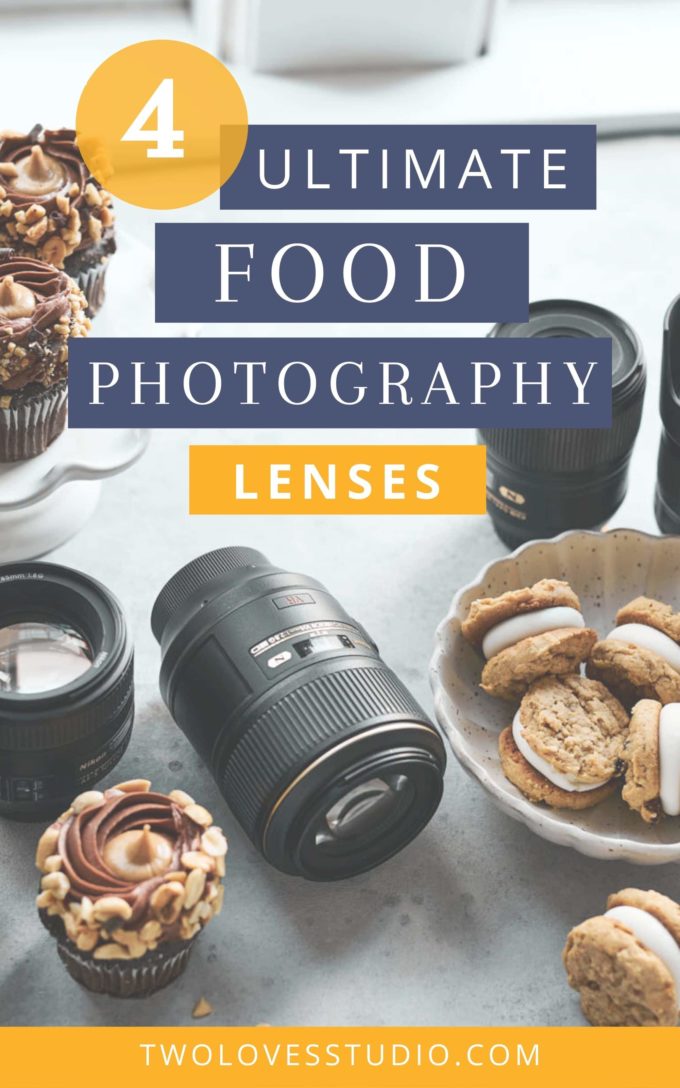
4 Ultimate Food Photography Lenses
I shoot Nikon, and I love the prime lenses in my kit. I use each of these lenses when I am working.
This post isn’t about ‘exactly which’ lens to buy, but rather to consider the focal length that is flattering for food photography.
When shopping for food photography lenses, consider the focal length of the lens and what you’re trying to capture.
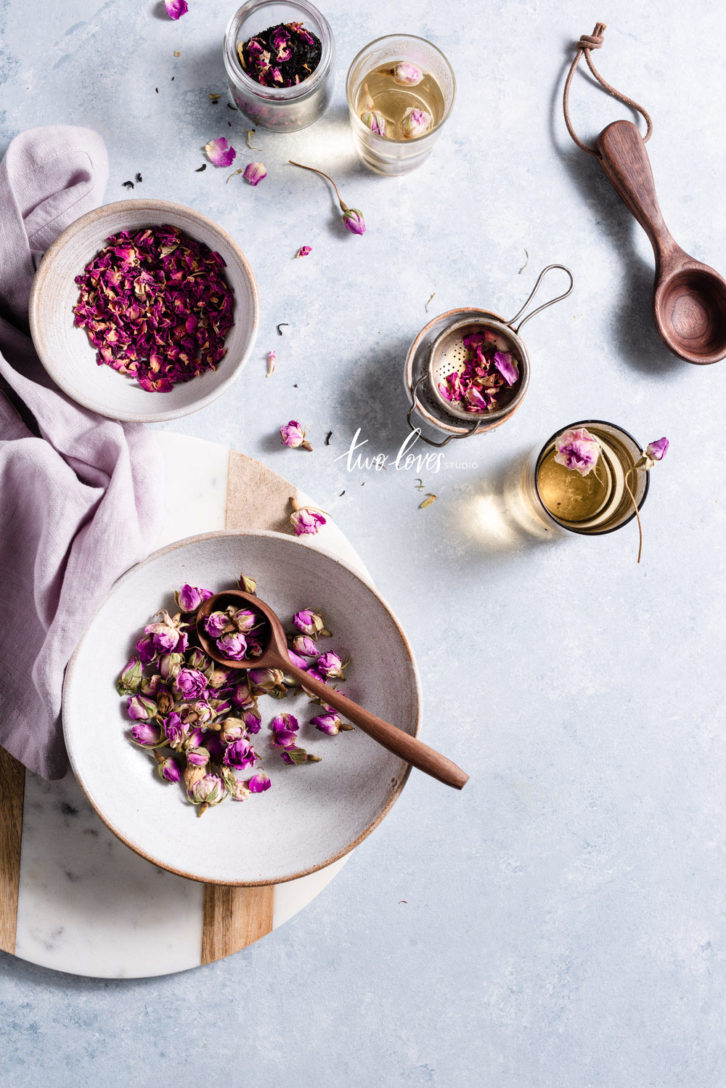
Read: The No.1 Mistake When Upgrading Your 18-50mm Lens
1. The 50mm ‘Nifty Fifty’
There is a reason why the 50mm is referred to as the ‘nifty fifty’.
It’s an inexpensive lens, lightweight, great quality for the price and its focal length lends itself to many styles of photography. As far as food photography lenses are concerned, this is your entry level lens.
But don’t let ‘entry level’ fool you.
This lens isn’t crap!
At its price point, it’s no wonder it has become a staple part of every photographer’s camera bag.
My Nikkor 50mm AF f/1.8D always go with me. On every shoot, on every holiday.
I wouldn’t say it is my favourite lens, but it is my ‘safe lens’. I can rely on it and it gets me out of tight spots.
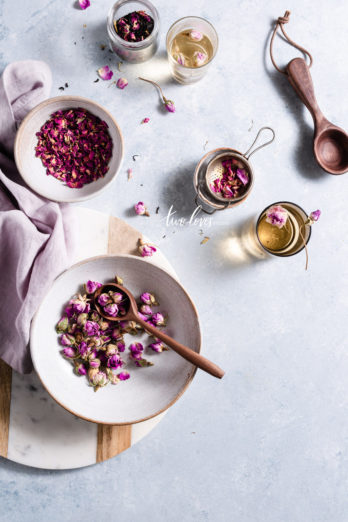
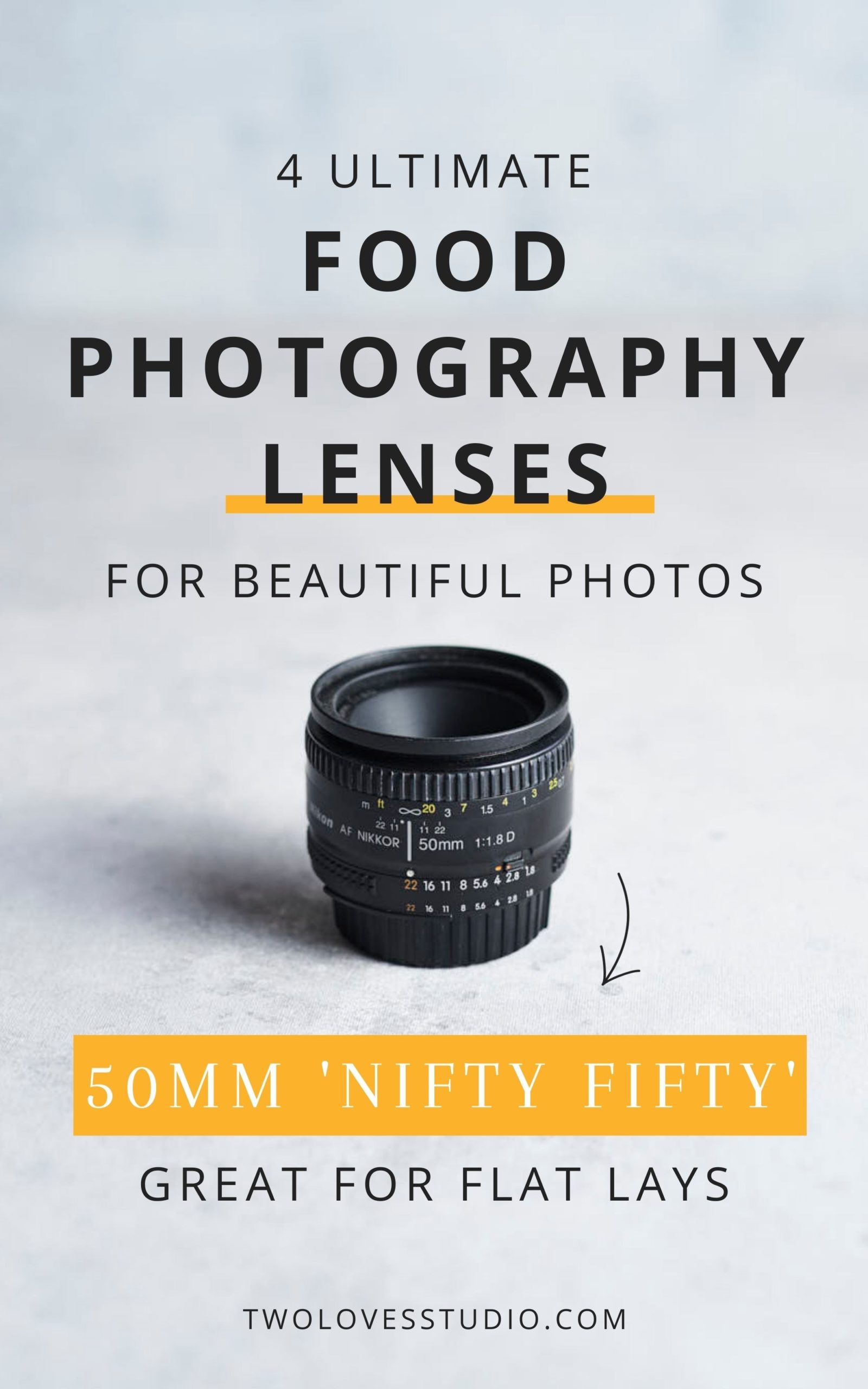
Why is the 50mm a great food photography lens?
It is great for flat lays, table scenes and capturing highly stylised stories where you need to include a lot of elements.
It’s a perfect lens to capture a wider scene so you can crop your images in post-processing to create a more powerful image without creating distortion that may come with a wider focal length such as a 35mm.
Use it in low light when you are shooting at cafes and restaurants as can go as high as f/1.4 and f/1.8.
50mm Food Photography Lens
How I use my 50mm
The 50mm is usually my first go to lens for flat lays and overhead shots where I am trying to capture quite a few elements that connect the viewer to my food story.
I will also use it to provide a wide crop for minimal shots where I want to play around the crop of the shot in post-processing.
If you are looking to add a text element as an overlay and negative space is key, I use this lens to provide that option.
As I don’t tend to shoot food beyond f/3.5, I don’t use this lens to its highest aperture, (being f/1.8). But this high aperture is sure handy to have in low light when you are far away from your subject.
I call this my ‘safe lens’ sometimes as I know if I am shooting on location or at a restaurant and the lighting is less than ideal I can get safe shots that will get me over the line.
Whilst not ideal to shoot subjects on a 45-degree angle, it is a much better option than a 35mm.
Read: How To Blur Your Background in Food Photography
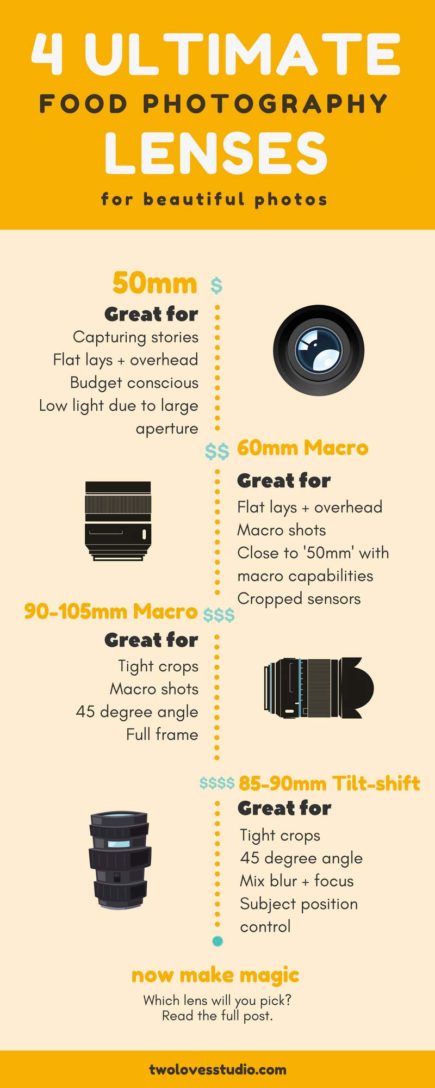
2. The 60mm Micro/ 6omm Macro
The Nikkor 60mm Micro AF-S 2.8G was the first lens that I purchased all by my wee self and remains one of my favourites.
It captures light so beautifully, is incredibly sharp, has one of the prettiest vignetting of any of my lenses and a short minimum focusing distance.
As far as food photography lenses go, this is one is for the smart photographer. Two-in-one, affordable and great quality. You can read more about which specific macro lens you should buy for your food photography in this post I wrote.
Why is the 60mm Macro a great food photography lens?
It’s the perfect combination of (nearly) ‘nifty fifty’ and macro in one.
Obviously, it is not the same crop as a 50mm, as it is a 60mm, but it is pretty darn close and has macro qualities to boot.
If you’re just getting started in investing in your lens collection this is a great combo of a 50mm with the versatility of macro qualities.
If your camera has a cropped sensor, (like my first camera Nikon D300 had a crop factor of 1.5), then the 60mm Macro will become more like a 90mm macro which is close to the professional Canon 100mm Macro.
Another killer lens on this list!
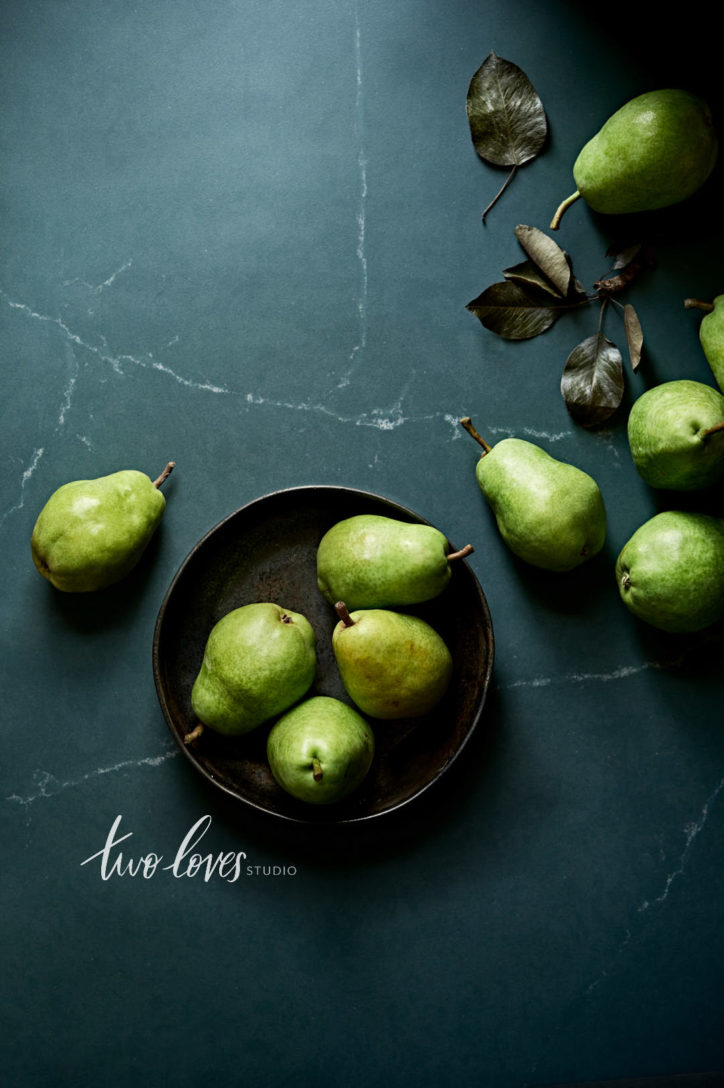
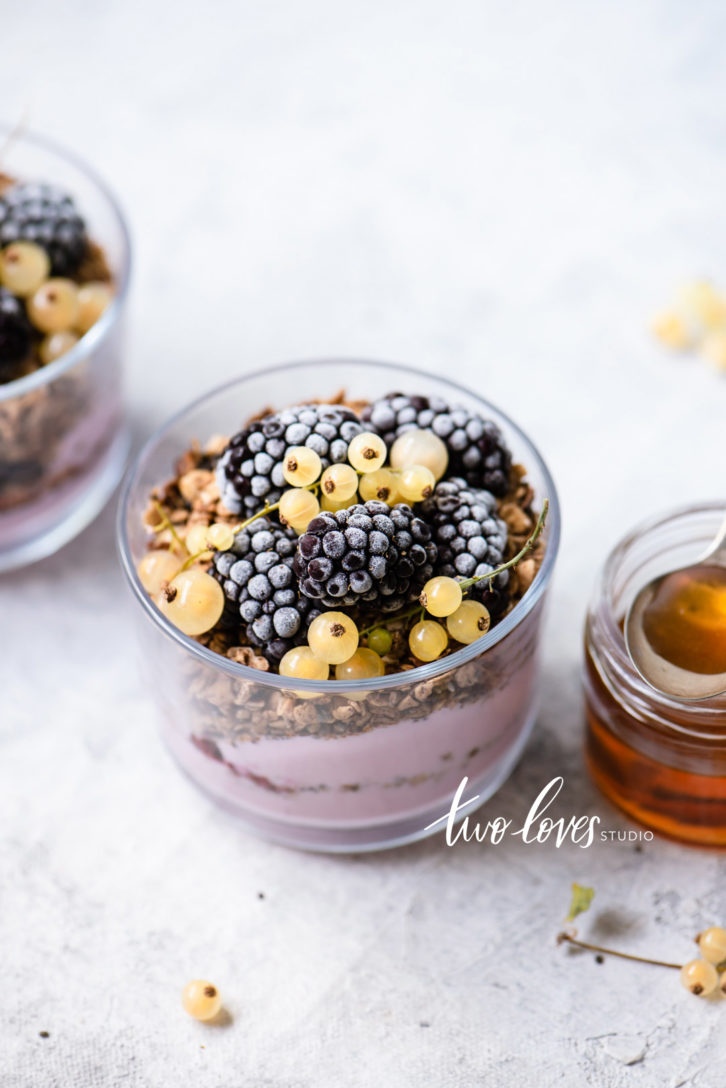
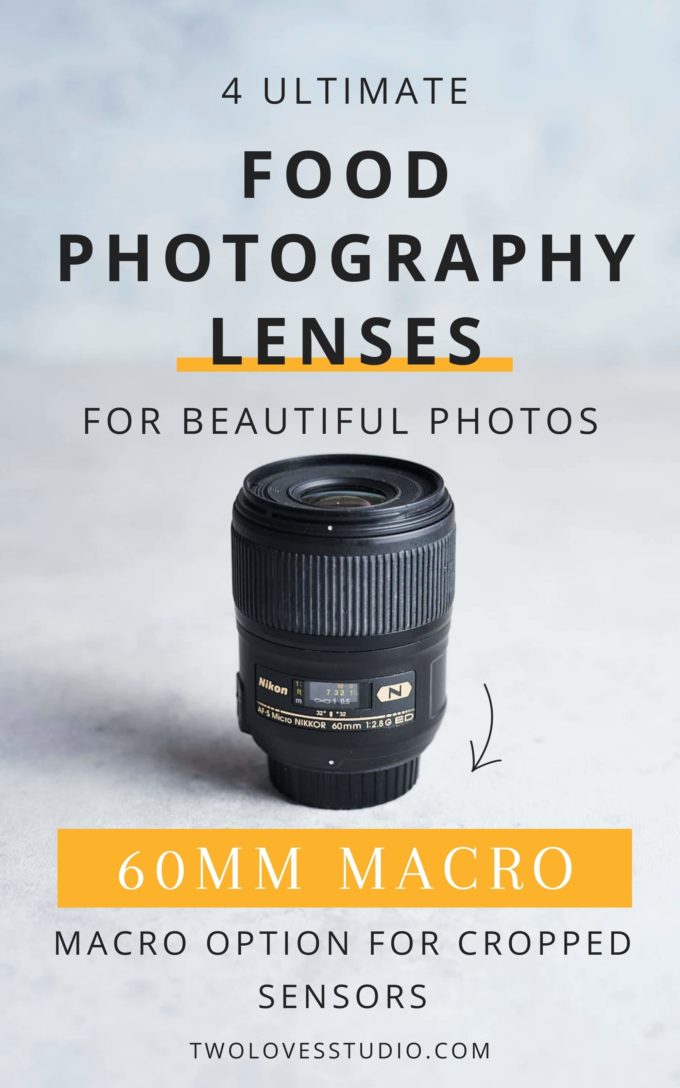
60mm Macro Food Photography Lens
How I use my Nikkor 60mm Micro AF-S f/2.8
I tend to use this lens like I would a 50mm. I shoot overhead with it a lot, especially when I need to get close to a subject.
When shooting at a 25-45 degree angle and I want to get a few more elements into the frame than a tighter crop like the 105mm allows for, I’ll go for this lens.
I rarely shoot below f/3.5 for a food shoot, so f/2.8 on this lens suits me perfectly.
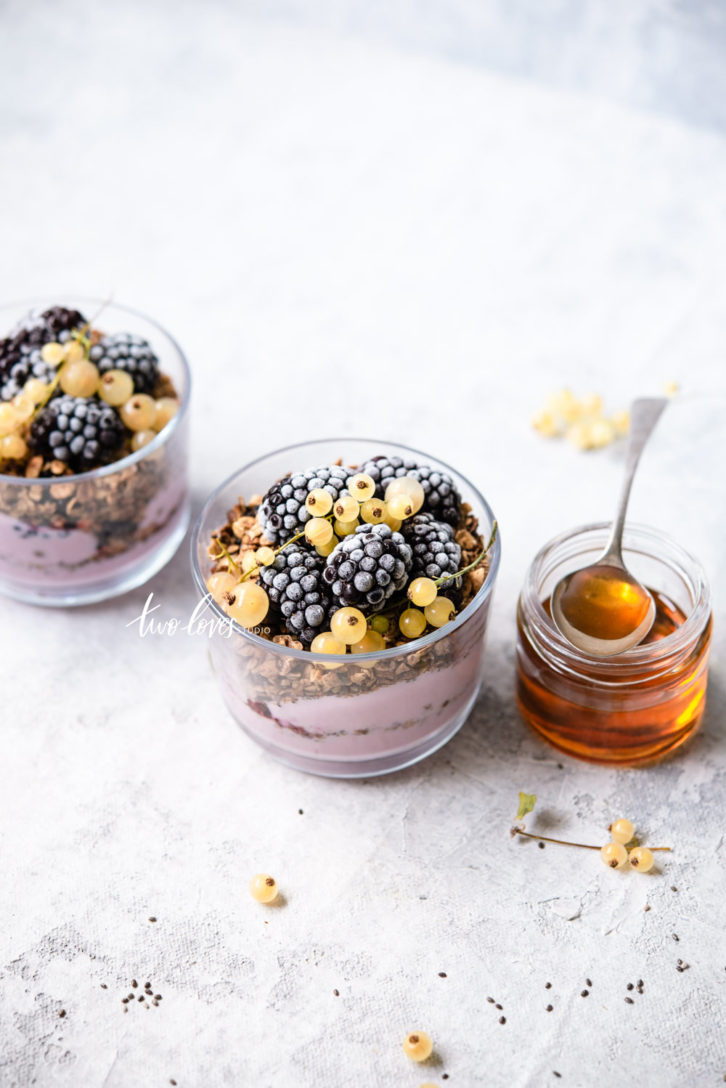
3. The 105mm Micro/ 100mm Macro
The Nikkor 105mm Micro f/2.8 is always with me on a food shoot.
Whilst food photography doesn’t equate to macro photography, (viewers will want to see more than a macro shot of a sesame seed on their burger), the ability to get close focus to your subject is where macro lenses come in handy.
As it is a more expensive lens when buying Nikon and Canon, Tamron also have a 90mm Macro that photographers I know swear by for a much more reasonable price.
Why is the 105mm Micro a great food photography lens?
It allows you to get those really flattering and tight 45 degree shots of your dish, whilst keeping a shallow depth of field for the background elements.
Wider angle lenses like the 50mm or the 60mm mentioned above don’t provide as flattering an image when used to capture your dish at 45 degrees.
The closer you get with these lenses to ‘crop’ the dish at 45 degrees, the more distortion you’ll see.
The dish won’t look right. A zoom lens like a 90-105mm focal length will provide much flattering images of your dish when shot at 45 degrees.
If you’re really considering adding a macro lens to your kit, you can read more about which macro lens to consider here.
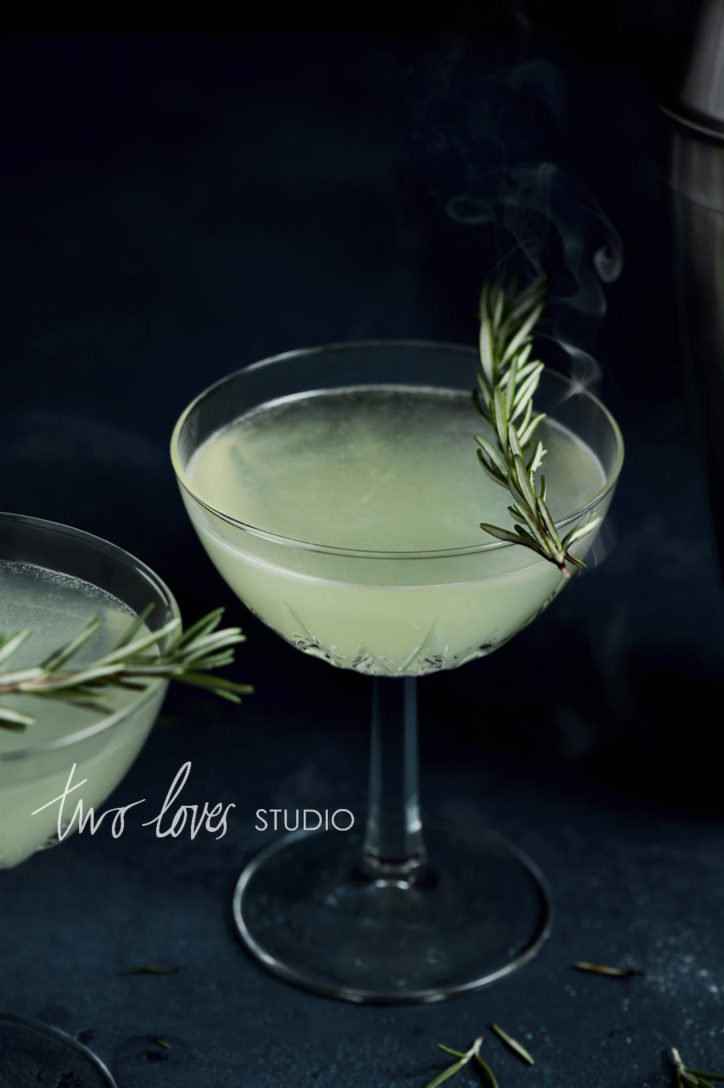
Shot with my Nikkor 105mm
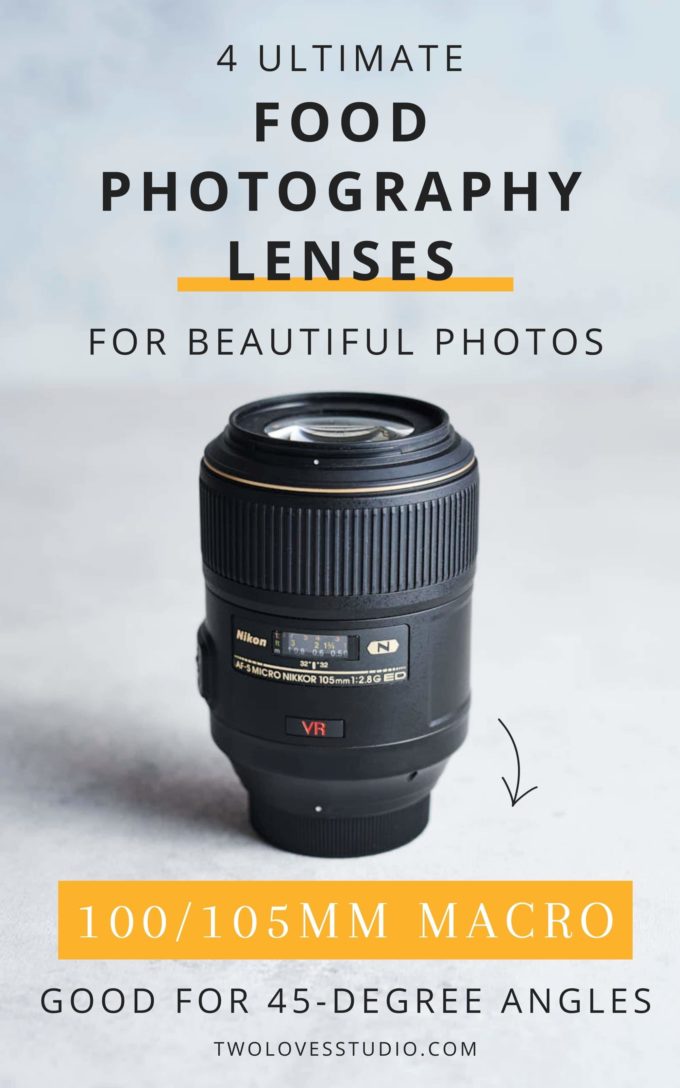
90-105mm Macro Food Photography Lens
How I use my Nikkor 105mm Micro
Overall I reserve this lens solely to shoot dishes with height at angles between 25 and 45 degrees.
I rarely shoot this lens at it’s highest aperture, choosing to stay around f/5.6 or f/8 as it has such a shallow depth of field.
The image is an example of this flattering angle shot at f/5.6. Still a gorgeous amount of blur!
As it is a very tight focal length, I do need to be a decent distance from the dish, so I need to have enough space to allow me to explore angles between 25-75 degrees.
This lens does have vibration reduction (VR) for when you are hand holding it, but my hands are still too shaky. I therefore primarily shoot with this lens on a tripod with VR off.
You can also shoot with this lens both overhead and straight on, I just tend to use other lenses for overhead and rarely shoot my subjects straight on.
There is no point in having a great lens if you’re not focusing on your subject correctly. You can read more in this post about how to use autofocus correctly in food photography.

4. The Tilt-Shift Lens
A zoom tilt-shift lens may just be a pro food photographer’s lens of choice. It allows you to precisely control the plane of focus like no other lens can.
(Alas I don’t have one, but I rent now when I need it for a job. It is the next lens of my list).
Mix of focus/blur control.
You can selectively control the plane of focus, allowing the dish at the front of the image to be super in focus, whilst the background story is superbly out of focus.
Angle/subject position control.
You can shoot a dish at its most flattering angle, and control how much of the story/props around the frame are included without changing the camera angle, distance or the subject placement.
This is really powerful for shooting cover or product/packaging images.
If you want to read more in-depth about the tilt-shift lens, you can read this post.
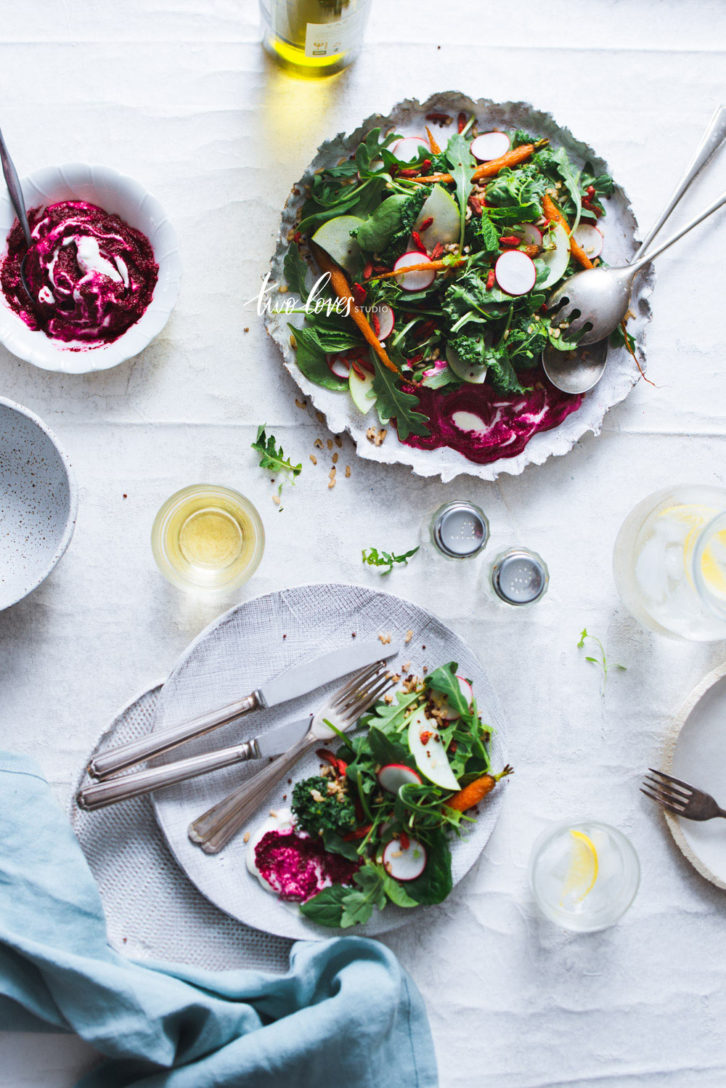
Why is the tilt-shift a great food photography lens?
You can shoot a dish in its most flattering angle, having full control over the plane of focus. Allowing the dish to be perfectly in focus, with the surrounding elements out of focus.

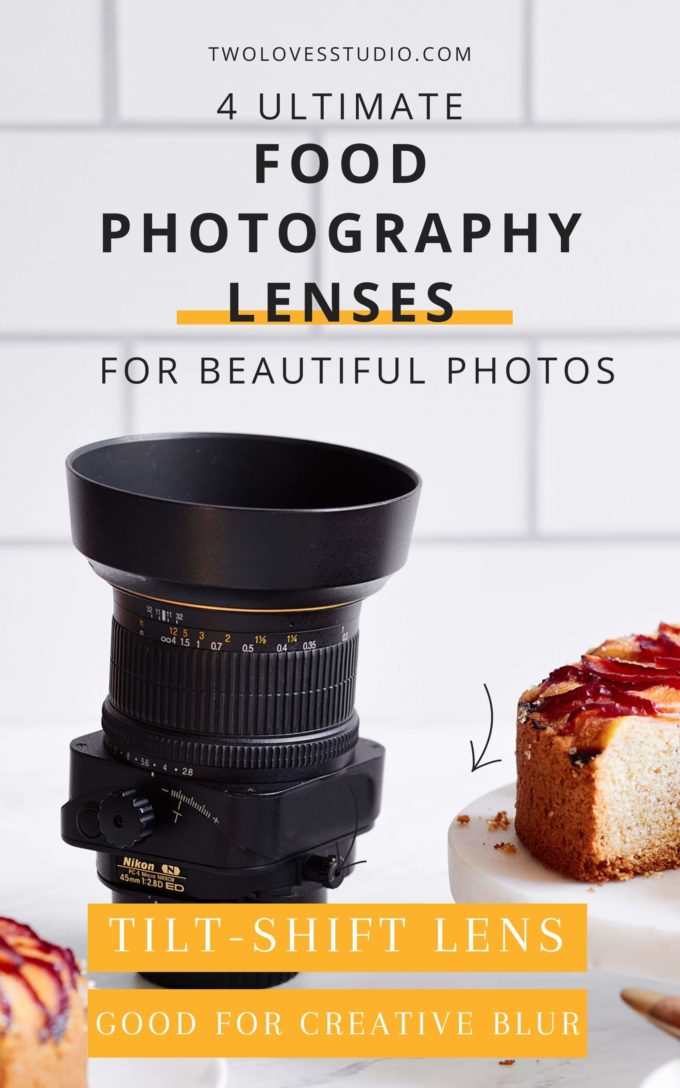
Tilt-Shift Lens For Food Photography
RELATED: Using A Tilt-Shift Lens In Food Photography
Are you looking for your next food photography lenses? Trying to create better food images? Let me know what you’re considering buying in the comments below.
Two Loves Studio was not paid to write this post, however, it may contain affiliate links. If you purchase an item from an affiliate link, we do get a commission on the sale which helps us run this site. Only affiliates for products/services we believe in appear on this site.




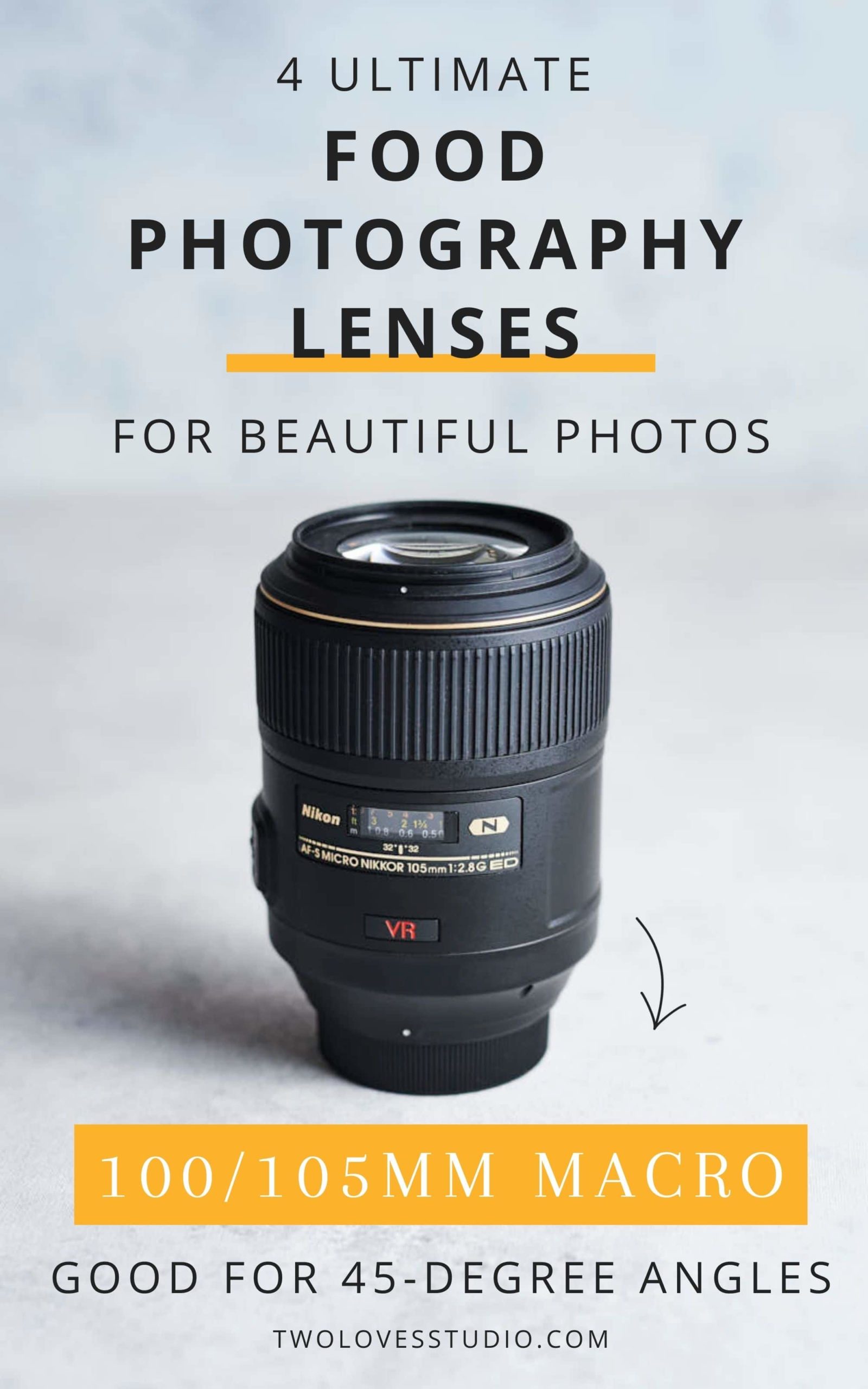
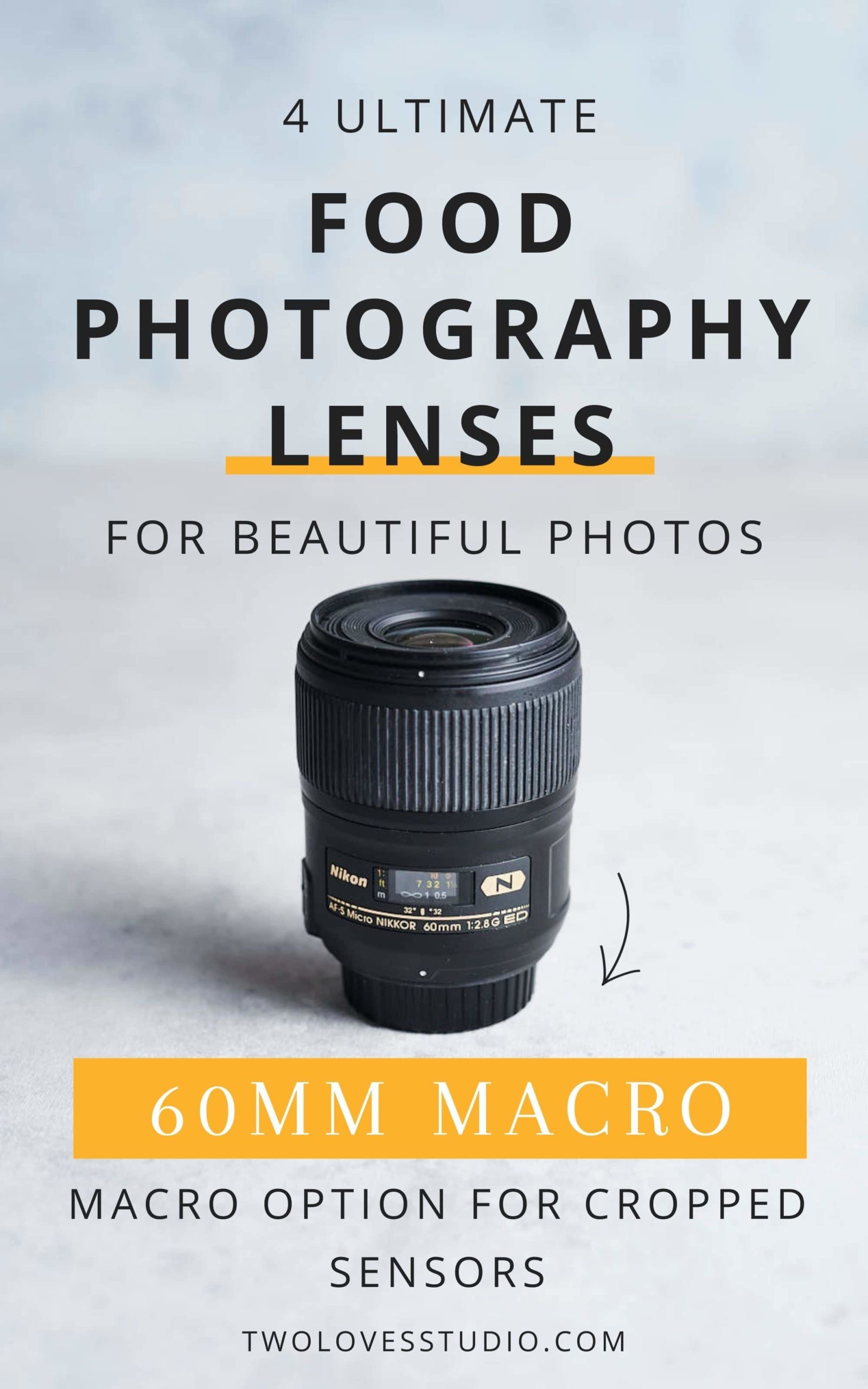
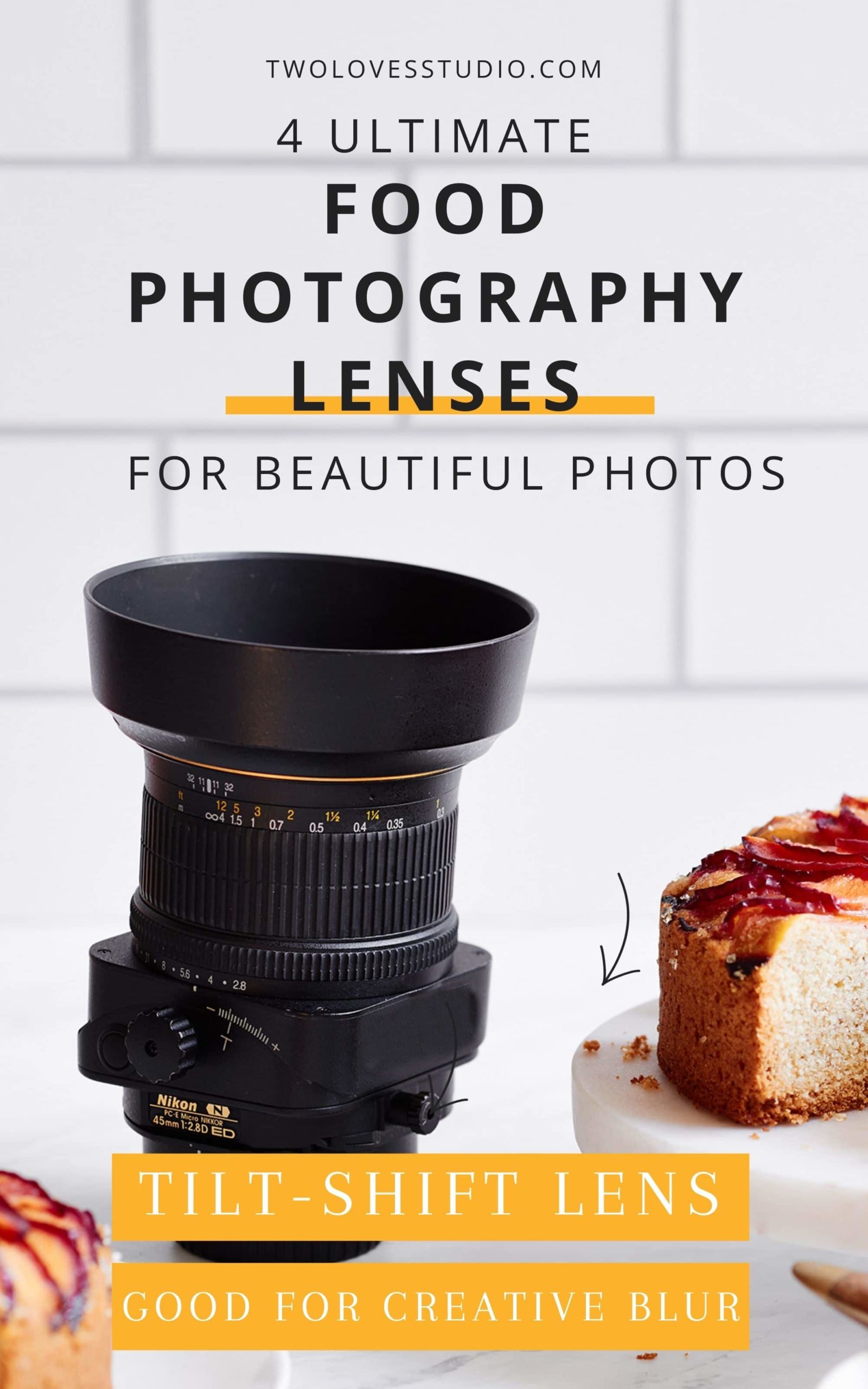
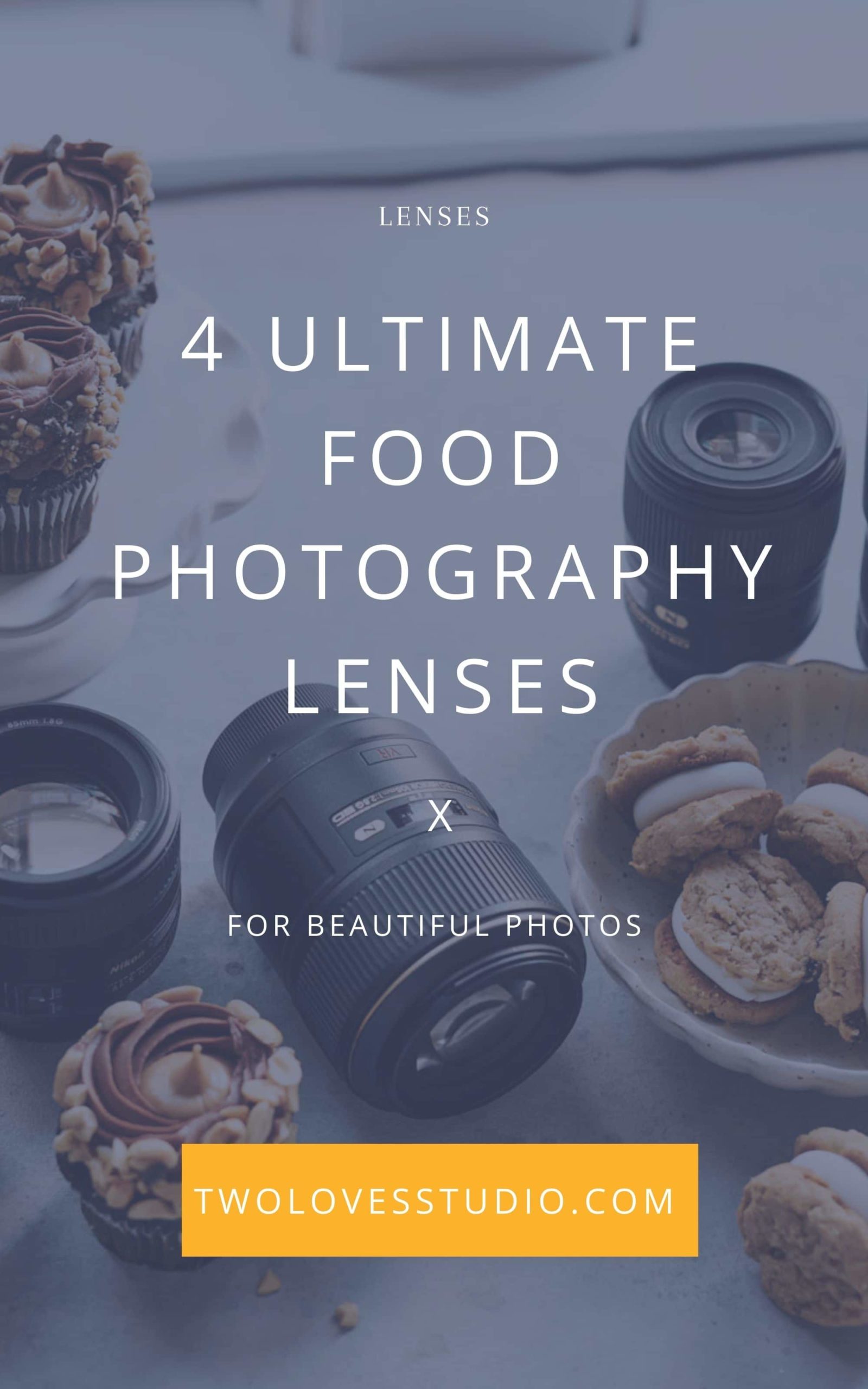
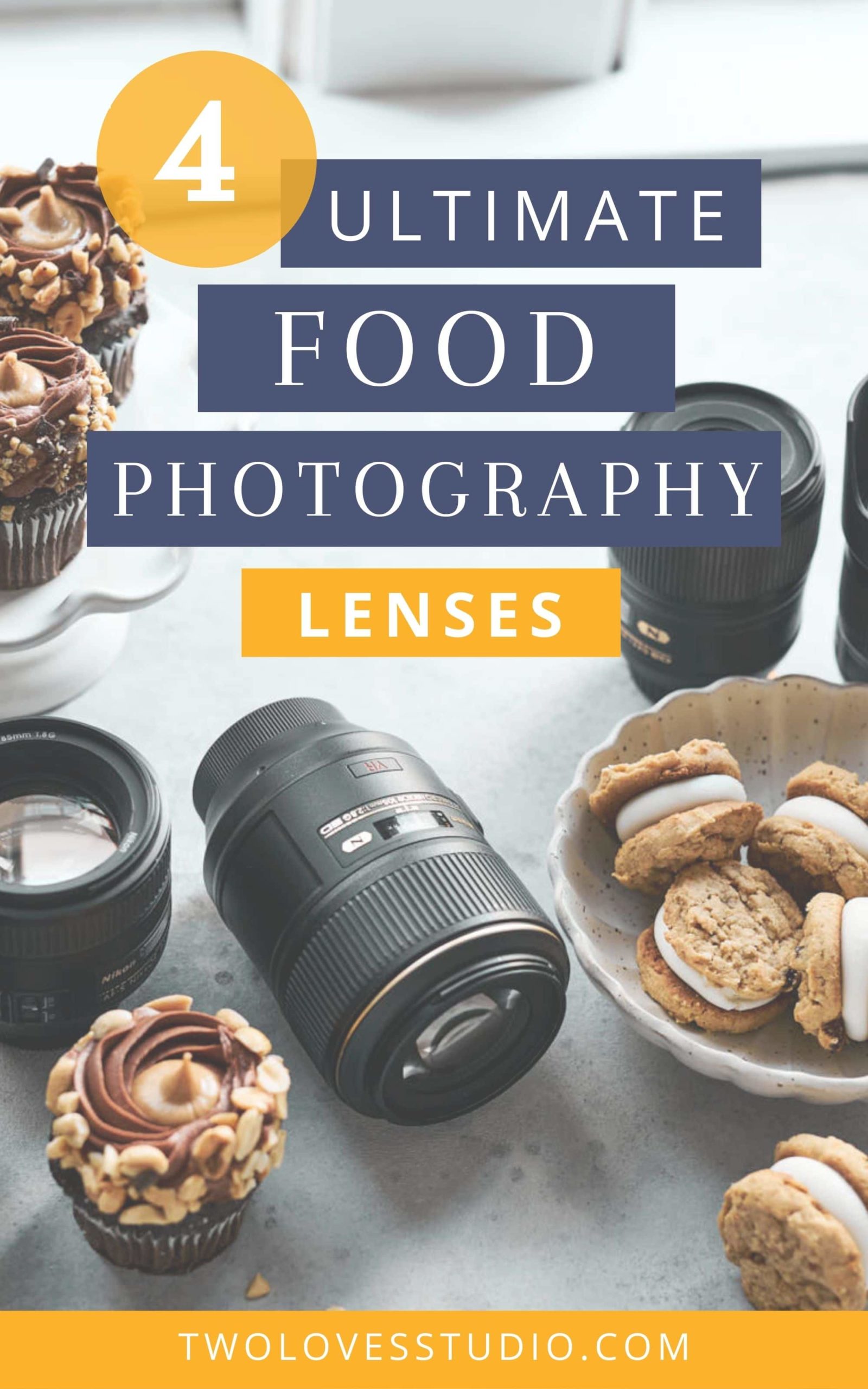
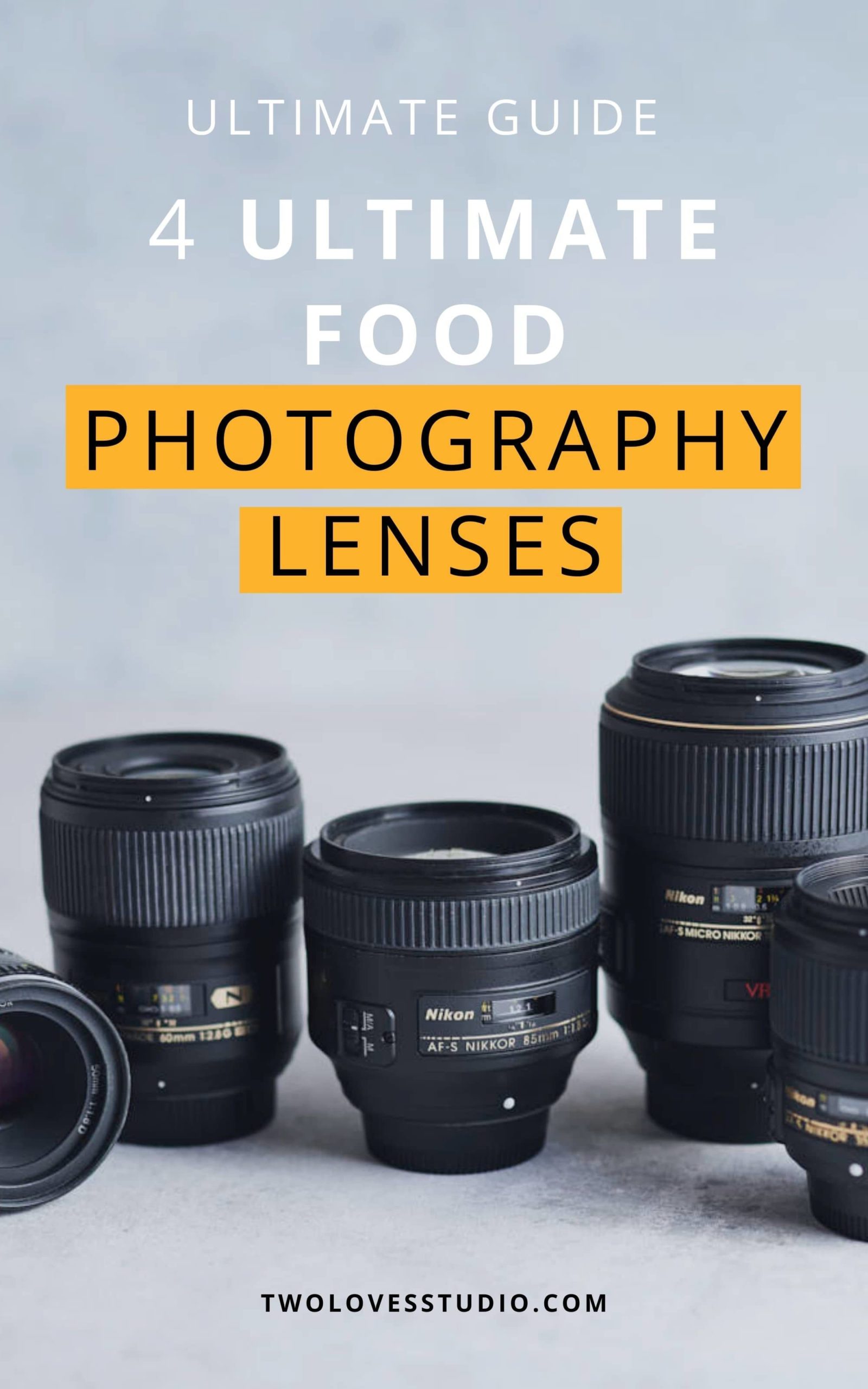

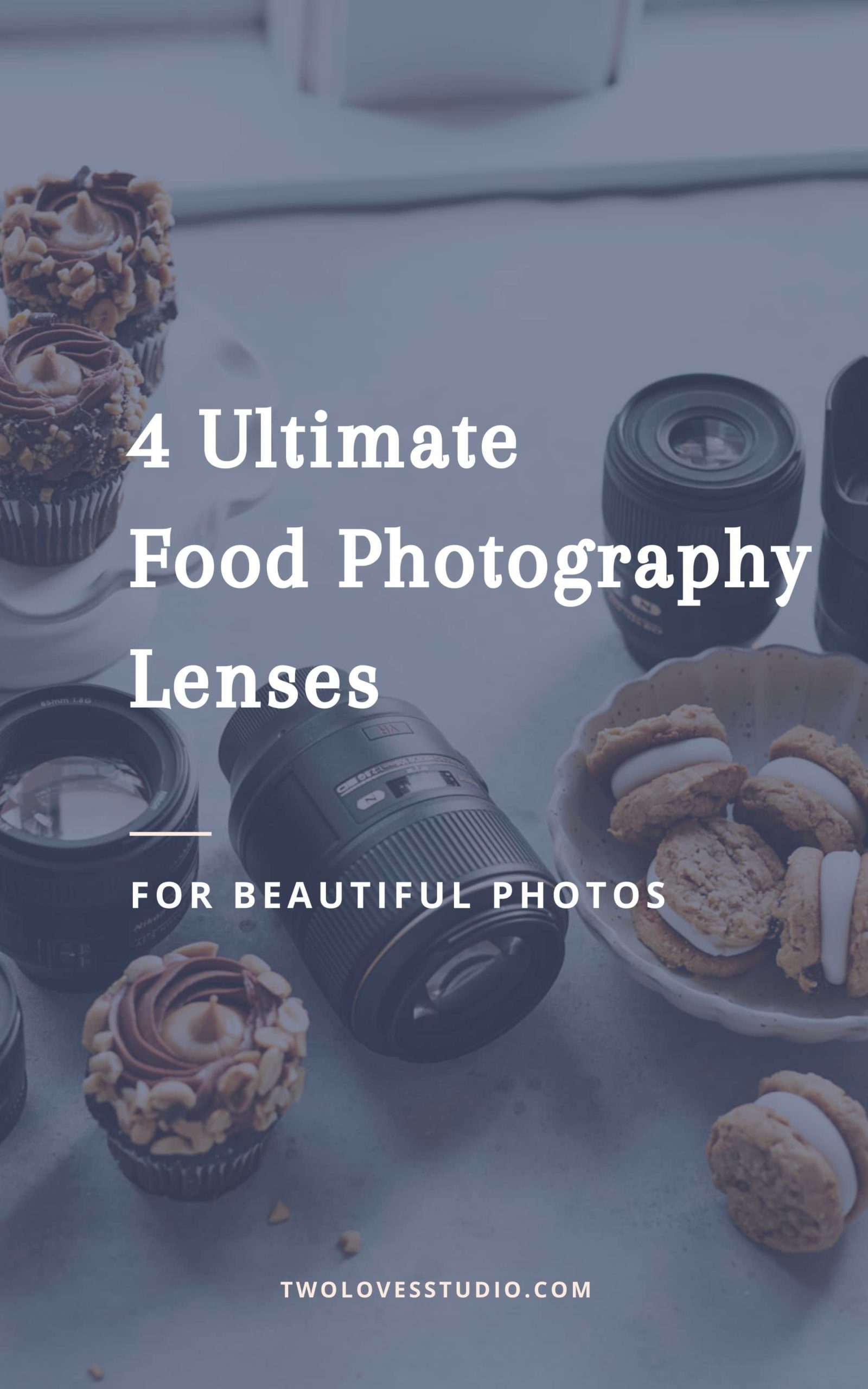
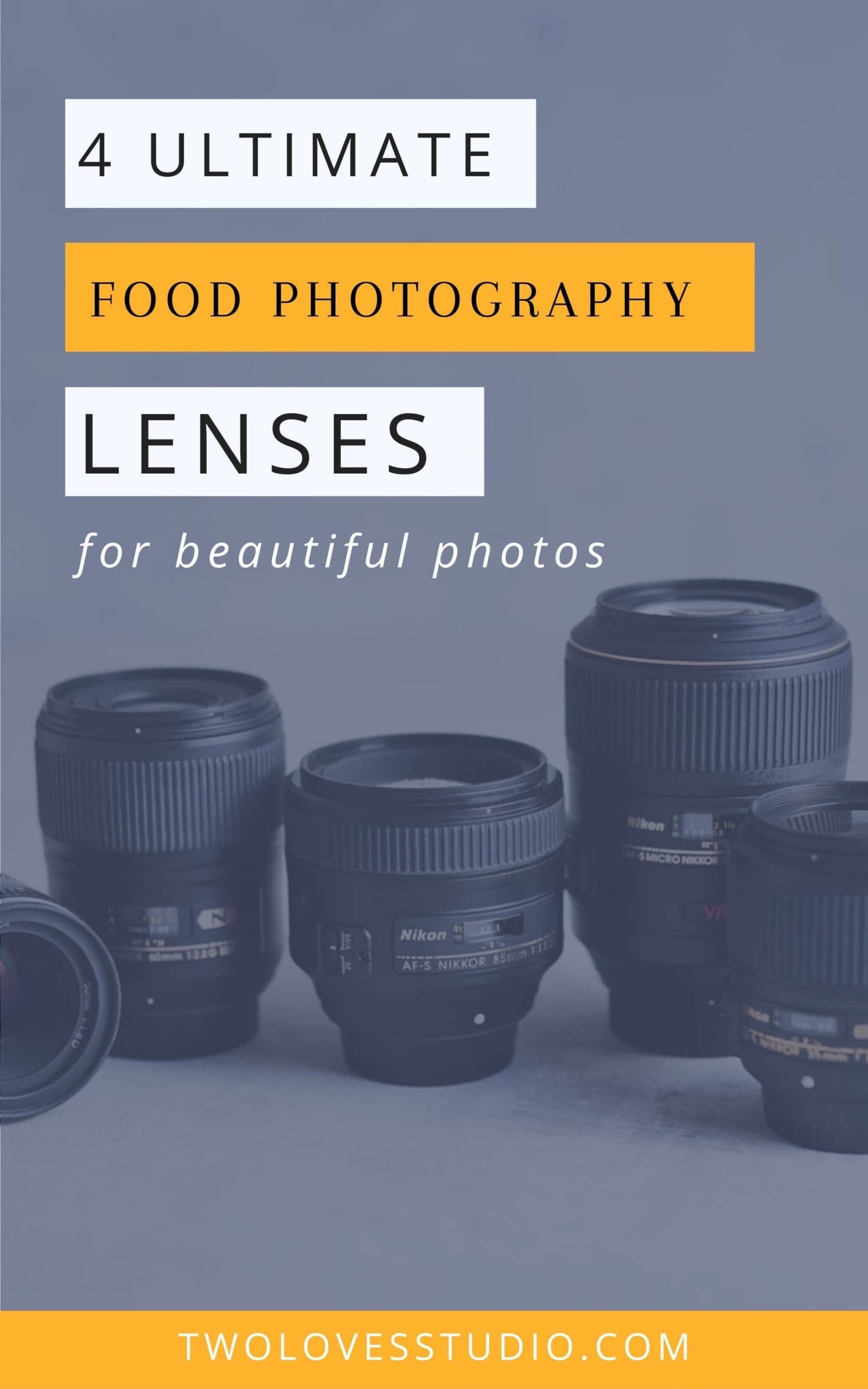
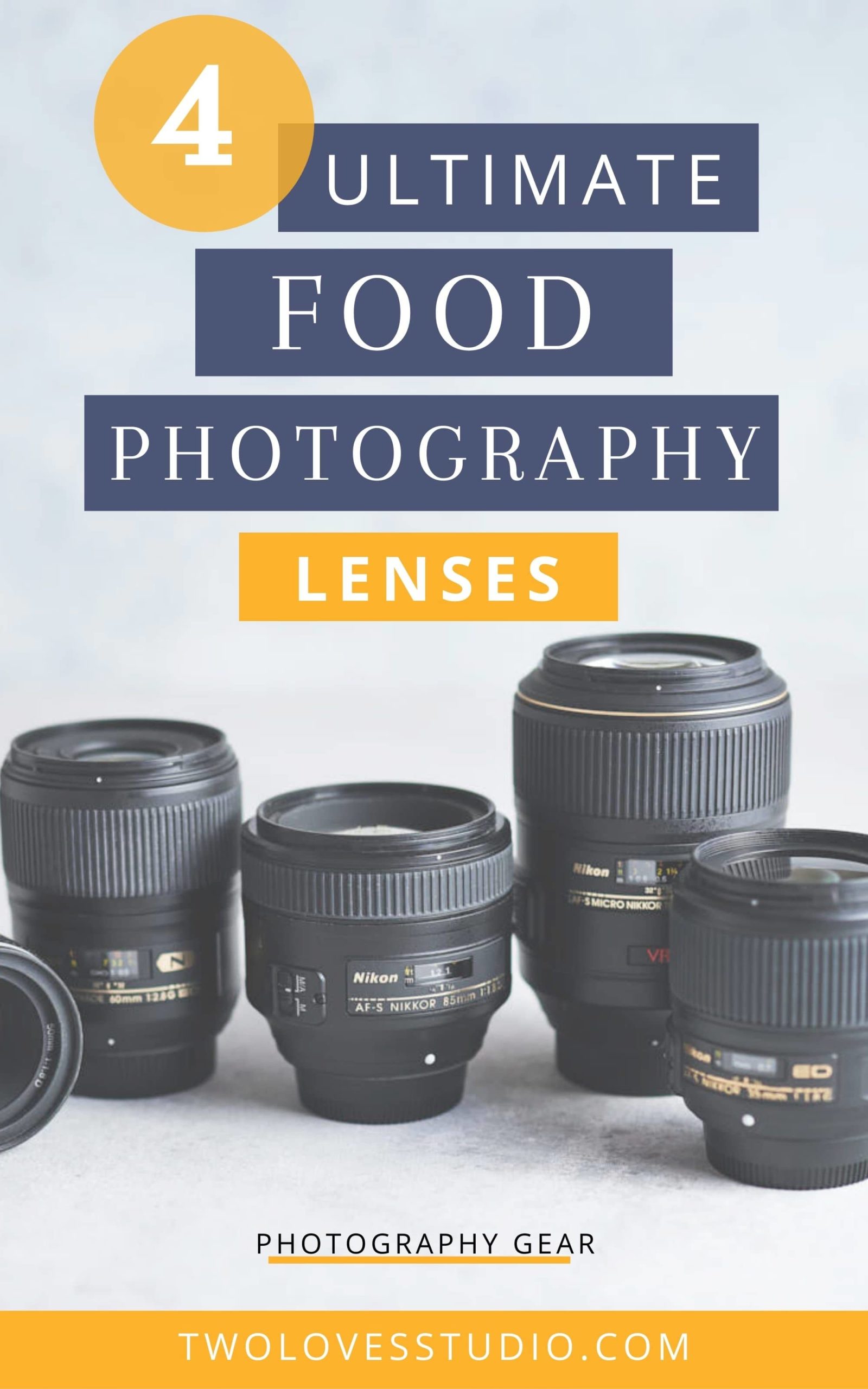

Amanda
Hi Rachel,
Thanks for a great post. Very helpful – I use two of the four listed but am still learning about their strengths. A question, what f-stop do you shoot your overhead shots at, please? You mentioned you keep it quite low and I tend to go higher but I am never happy with my overheads. Perhaps my f-stop is my issue.
Rachel
Hey Amanda, so glad you found it helpful! Some of these types of questions in photography are kinda like ‘how long is a piece of string’! It is so dependant on many factors that there isn’t a hard and fast rule. It will depend on how close you are to your subject, the heights of your subjects, the look you are trying to create and the lighting. I’d say if my lighting is fairly decent then I would start around f/5.6-f/4.5.
Chaimae
Wah… There’s no more accurate word to describe these beautiful photographs ! The color of this beverage is mesmerizing ! Thank you, your blog is by far one of my favorite (even if there’s no recipes on it) because you’re always full of advices and (very) useful tips and how-to about food photography ! We can see you love your job (and maybe that’s the reason you’re good at it haha =D)
Thank you ^__^
Rachel
Yep, no recipes around here. The internet is filled with so many great ones already. Thanks for the very kind words!
Melissa
Alright now you’ve got me all confused. Ha. I’ve been saving for a new lense and thought I knew what I wanted. I’ve got a nifty 50 f/1.8, and a 24-105 f/4 L . I wanted to invest in a prime or maybe a macro lense of some sort. What would you recommend as the next investment as a food photographer? I was thinking maybe a 90mm macro or a 85mm prime? Thoughts/recommendations? I can’t decide.
Rachel
There is rarely such a simple answer when it comes to a new lens right? Do you have a cropped sensor or a full frame? I would first think about the shots that you really want to get but can’t with your current lenses. I find that helps steer me in the right direction.
Melissa
I’ve got a full frame camera. Maybe thinking of a macro since I don’t have one.
Jonathan Thompson
Hey Melissa, have you thought of using macro extension tubes with your current lenses. They fit between the lens and the camera body allowing your regular lens to focus at a close up distance for really tight, macro shots. You can pick them up for £25-35 on Amazon.
If you’re using your 24-105 for food and you use Adobe Lightroom to edit and organise your images, you can search your food photography folder and see what focal length you’re using the most. If you’re around 85, maybe that’s a good call, if it’s more around 100, you have more relevant info to make an informed decision.
I always tell people to really work the kit they’ve already got. You have a focal range which is more than enough. If the image quality isn’t there, due to the lens, maybe it’s time to change up the kit. Often I found myself looking to more kit to solve a shooting issue, when it was me that needed to change things up and my technique.
I’m pretty certain you’re shooting Canon. My 50 1,8 isn’t very sharp, until I get to f8, which is fine for overhead. The 24-105 is a bit of an old girl too, not the sharpest piece of glass in my bag, and there’s a new one coming out. I use the 100 f2.8L Macro, there’s a cheaper version I’d be tempted to purchase 1st, see if you like it, perhaps it will be great for you and no need to invest so much in the L lens. If you want to upgrade after 6 months because you love the 100 macro, then sell it and buy the L version, which is very good. Even renting a lens before the big buy can be a good route for some.
I hope all that makes sense.
Rachel
Always a pleasure having your thought here, especially being a Canon shooter! Obviously most of my experience is with Nikon. I always, always rent or borrow lenses where possible. I know not everyone has that luxury. But something to think about for sure. What is your favourite lens?
Jonathan Thompson
Ahh, thanks Rachel, I hate to see folks struggling with the same stuff I did starting out. I actually go a different route to most. After a recent business coach meeting and running through my personality and traits, doesn’t surprise me now. I mostly use the new 24-70 f4 with astonishing IS (Image Stabilising for anyone reading who doesn’t know) It’s reeeeeeeally sharp and covers the focal length I’m often using, 50-70, it can also do macro detail shots and no lens changing. I also bring in the saucy minx of my camera bag, the 100 Macro f2.8 L IS. Some how I always get a shot and view point I like with this lens. I even dusted off my 70-200 f2.8L the other day, just for giggles, and it brought in a view point I hadn’t thought of before and only that lens was going to give it to me. If the crowd is doing one thing I’ll be somewhere else experimenting. That doesn’t mean the crowd is wrong, but I can get creatively claustrophobic.
With my subject matter being more varied than most my kit tends to be a little different. I’ll be borrowing a tilty shifty for some focal plane fun as the summer wanes for us and makes it’s way over to you. Play time is a good time 🙂
Rachel
That would be my pick for you where price permits. The 100mm before the 60mm. If you can rent one or borrow to test out before buying is ideal. Jon makes some good points! I haven’t done that myself, but I knew I would have the lens for life so saved up for it. Tamron is also a really good option. Jo from The Luminous Kitchen loves her 90mm Tamron macro.
Marisa Franca @ All Our Way
Hi, Rachel! This is such a good article. I’ll be sharing it with my food photography groups. I have a Nikon D7200 and my first lens is a Nikkor AF-S 50mm 1.4G. I plan on getting another food lens and an all around lens. Taking into consideration the crop factor, which lens would serve me the best? We are traveling for a month and I’d love a lens for outdoor shots and then my next food lens. I am getting the full frame lens because should I ever upgrade to a full- frame camera I wouldn’t want to start over.
I looked at your workshop. Wish I could have been there. BTW did you have anything covering the windows to diffuse the light?
Rachel
Hey Marisa, do you mean diffuse the light at the workshop or in the images in this blog post?
Is there shots that you currently want to get but aren’t able to with the lens you have? The 35mm is a good lens on a cropped camera as it will give you the feel of a 50mm. If you ever upgrade to a full frame the 35mm is really awesome for journalistic and travel photography and I know you travel often! I’d say if you see yourself using it for travel in the future (when a full frame comes along) then this will work well for you.
shibani
lovely article Rachel. I really need the Tilt – Shift lens. Have seen the pictures shot from this lens. Totally different.
Rachel
You and me both Shibani!
Michele Garcia
Thanks Rachel-very helpful post! I just upgraded to a Nikon D810 ( from a D80) and purchased the 50mm f1.8G, and I have a 24-120mm 4G that came with the body. My D80 was a great starter camera, especially when I added a 40mm f2.8G lens, but I love the greater range and flexibility I have now with the D810. I will keep this list for future reference!
Rachel
That’s amazing Michele. I have the D800E so quite similar. It’s such an amazing experience when you get to full frame and see the lenses focal length for actually what it is. The world if your oyster now!
Angelica
I am very new to food photography, why does it say 105 mm Micro/ 100 mm Macro? Or 60 mm Micro/ 60 mm Macro? Are those different lenses? My first le se was. 50 mm f 1.8 Canon lense, I’m saving for the next one, a macro lense, I was told the 35 mm would be a good purchase, but now I’m consideran de 60 mm, what do you think? Thanks 🙂
Rachel
Hey Angelica. Good question. If you take a look at the name of the lenses and the images of the lenses, you’ll notice that the Nikon macro lens is called a ‘micro’ lens and the Canon version is simply the ‘macro’. Essentially Nikon calls their macro lenses ‘micro lenses’. I shoot Nikon, and I know there are a lot of readers who have Canon, so I put both lenses up there.
Do you have a cropped sensor or a full frame? The reason they say the 35mm is a good lens for a cropped sensor if that it will give you the feel of a 50mm. Which lends itself quiet well to food photography. If you ever upgrade to a full frame the 35mm won’t be so good for food photography anymore but rather travel and journalistic style images. Not a bad lens to have though as food often ties in with travel. I think a macro lens for food photography is really a must. If you can, I always advise to rent your options and see what you like. I’ve always done that in the past before I purchase.
Angelica
Thanks Rachel, I have a cropped sensor, I’m still trying to understand how does that work, and what does it mean. I’m reading the article you mention here
Rachel
Did that article help you at all Angelica? It can be confusing at first. I would have a think about what your lens current can’t do for you, and some sample images of what you’d like to create. Then we can see what sort of lens would suit that. Let me know!
Angelica
Thanks Rachel, I’m still trying to understand the effect of cropped camera, I need to read the article a few more times. i would love to be able to capture the texture of the food a little closer, for some things, like the little parts of the berries, or the sprinkles on a cupcake or the texture of puff pastry, that’s why I was thinking on getting a macro. i usually shoot with the 50 mm and I do some of the overhead photos with de 18-55 mm Lens that came with the camera, because I find it easier to Fiat everything in the frame with that lense, e en if I’m on a little bench I have to do this.
I also want to let you know that you have inspired me to start My own A-Z project, Fritz and vegeta les, and I will be posting on My blog. :). So far, I’m on the letter C
Rachel
I know it’s hard to grasp, but it will come and will really help you to make the right choices for what you are trying to achieve. I’d look into renting one if you can and have a play! If you still can’t work it out, please send me an email with what your struggling with and I will see if I can put it into a blog post for the future.
I am pumped to hear about your A-Z project. You will learn a tonne of stuff! I like the little flower sugar cookies you have on there!
Heather @Boston Girl Bakes
Such a well done article- the best I’ve read on food photography lenses! I’ve pinned it already! And now I want a 60 mm macro lens 🙂 And love the idea of renting a lens before purchasing..no idea you could do that! Great advice!
Rachel
Oh Heather, you’re so sweet! Happy to heat that. I aim to teach. Yes, I always rent one. They are so pricey that it’s a blind commitment when you first start and are just beginning to understand lenses.
Ami T
Hi Rachel, thank you for another lovely post. I still remember the first day I found you on pinterest (2 years ago), I went on a “pinning” marathon of your blog. Your pictures and advices never once disappointed me 🙂
A question for you, so I have a cropped d7000, a 35mm fixed and a 50mm fixed. I plan to shoot scenery (travel) and food mainly, so the Tokina 11-16mm is on my shopping list. However i am thinking of selling the 50mm to get a macro lense mainly for food, do you recommend the 60 over 105 or 90 tamron?
Thank you so much!
Ami
Rachel
Hey Ami! That is so lovely to hear. Great question. For me, I would think about whether I was ever going to upgrade to a full frame in the future. As that drove my lens choices when I was starting out. The 50mm is a great lens to have, (when it is actually a 50mm). The 60mm, 105mm and 90mm macros you mentioned are all great lenses, it just comes down to how you will be able to utilise them with your cropped sensor. The 60mm will be more like a 90mm, whereas the 105mm will be more like a 150mm (as I am sure you’re aware). If you were shooting with a full frame I would say the 90mm/105mm before the 60mm, but they will be so incredibly close that I would chose the 60mm over those for a cropped sensor. I have a full frame and I often use my 60mm, it is one of my favourite lenses so definitely isn’t a waste of a purchase if you upgrade to full frame. I hope that helps you. If you are able to rent some options before you purchase I highly recommend doing that as there is nothing quite like a test run to see if the results of the focal length will work for you.
Kiki
Phew – glad I already own 3 out of 4 lenses, the 50, 60 and 105. I like them all, and the 60 is one I use for “everyday” photography and not specifically for macros. What realised on reading your post is that I never consciously think about angles in degrees. I think I need to pay more attention to that.
Rachel
Wow! I used the 60mm for everyday too. It is a great lens. Did you have another way that you thought about angles? I’m intrigued.
Livia
I just bought my first DSLR and want to use this for food photos. I’m a little confused. Would the 50 mm or 35 mm be better? I have a 1.6 crop sensor on the Canon t5i so my understanding is that the 50 mm will feel more like an 80mm? (ish?) and the 35 will feel more like the 50? which in essence is better then? the 35mm? but once on a full body the 35 wont be good for food because now its an actual 35mm? I was told to buy the 50mm for food photography but now it seems like the 35mm is better on a crop sensor? Can you clarify for me?
Rachel
Hey Livia, thanks for reaching out! It sure can feel like a minefield to begin with. A lot of people will tell you a 50mm is a great lens (and they are correct), but the power lies in you figuring out exactly what you’re trying to achieve in your work. Personally I think a focal length of 50mm-85mm is a great place to start. 50mm will allow you to get more of a story into your scene and 85mm will allow you to capture intimate/minimalistic details of the dish itself. If you want a good all rounder lens, then the 50mm is your first choice. SO if you have a cropped sensor this would be a 35mm. Always invest in quality lenses and get the best for your money as your lens kit should grow with you no matter what camera you have.
I think it is important to think about the future and if you will have a full frame, but at the same time you’ve got to be able to get the shots you want now. Life only happens in the present moment and that is where learning happens too.
The thing about the nifty fifty is that you can pick up a really good one for real cheap. If you think you’ll want to upgrade in the future and have some space/distance to play with this lens then to get more in the frame you’d just move further from your subject. If on the other hand you think you’ll never upgrade and space is an issue then get the 35mm.
As always, I recommend trying to rent or borrow these lenses to test them out before you commit. Having each one in the space in which you shoot in will instantly allow you to work out what is right for what you are trying to achieve!
Livia
Thank you so much for your reply and your educated opninion. It’s very appreciated. You’ve also helped clarify for me the specs. I can now visualize how these lenses differ 🙂
Livia
Actually I have one more question for clarification if you don’t mind. Why would one buy the nifty fifty (50mm) lense if they have a kit lens of 18-55mm? I’m confused. Wouldn’t an 18-55mm have a broader range than just the 50mm? On the cropped sensor of 1.6 the 50 shoots like an 80mm but The 18-55mm would shoot like a 28-88mm. Wouldn’t that make buying the 50mm a waste because you can get that out of your 18-55? I may be totally wrong and just not understanding H kit lense? Please explain? LoL
Rachel
Sure Livia! This is a great question and I am glad that you are thinking of these things rather than blindly following advice from others. There are so many factors to take into account with a lens purchase, and when you’re buying a lens there is more to it than just the focal length. E.g you buy a lens for the maximum aperture, the bokeh and vignette, whether it is a prime or a zoom, minimum focusing distance etc. Depending on the subject you shoot, these factors will have different weights on your decision.
So the nitty gritty for your case (and a lot of new photographers will have the 18-55mm lens kit)… Prime lenses tend to be sharper than a entry level zoom kit like this one. You will also be able to have more access to maximum aperture levels, like f/1.4-1.8. Your lens kits max aperture is f/3.5. Whilst food isn’t shot at large apertures, it is nice to have when you shoot other things. The other thing to take into account is lens usually aren’t as sharp at their largest aperture. So if you got a 50mm 1.4, and you’re shooting around f/4.5 your lens will be sharper at that aperture than your current lens kit.
If you are happy with using this lens at 35mm (to replicate a 50mm) then you can always save your money and invest in another lens. Be sure to work out what you want to achieve with a new lens that your current one isn’t allowing you to create!
Livia
Again, thank you so much. This has helped me tremendously!
Kai New York food photographer
50mm and 60mm might be redundant. I would add 200mm. That focal length create some really beautiful shot.
Rachel
Hey Kai! Yes a good photographer friend of mine Jonathan Thompson would absolutely agree with you on the 200mm! I am assuming that you are referring to have BOTH the 50mm and 60mm together? That’s a fair point. I do have and use both, but I think educating on both is powerful as everyone’s budget is different. Not essential to buy together if you’re starting out for sure. Like I always say, it’s best to work out what you want in a new lens so you can make a powerful choice!
Heather
Love your site- so much helpful information!!! Question what do you recommend for those tabletop straight on shots to maybe get like a shot of a tower of cookies let’s say or something like that? I’ve been stuck in a rut using my 18-135 mm lens so I’m excited to break out my 50 mm/f1.8 again and see what I can do with it!
Rachel
Glad you found it resourceful Heather! I would say for straight on shots like you are describing I would be using either the 60mm on a cropped sensor or the 100-105mm on a full frame. You could definitely use your 18-135mm, but be sure to make it like a pseudo prime lens (there is an exercise on this in my free resources library). This was you are moving your feet instead of the lens and getting a different perspective.
Heather
Quick question- Have you ever tried using macro filters before? Would they be equivalent to a 60mm macro? I’ve been using my 50 mm f1.8 but feel like it doesn’t capture enough detail so looking to upgrade
Rachel
I actually have not used them myself, but my husband has and he says they can be pretty good. Obviously not the same quality but it depends on what you’re going for. They might be able to get you 90% of the way there.
Nehemiah
Hi Rachel, I am currently a student. I did quite a bit of research and I am not sure which one to go for however I shortlisted to 50mm f1.4/1.8(afs or afd, not sure which one will suit for me), 105mm VR f2.8, or the 100mm Tokina atx pro f2.8. I am planning to use it for macro/food/street photography. I do not have lots of funds to go for but I can save up if it is useful. Which would you recommend? I am using D7100 currently. I hope to have some advice from a famous food photographer like you! Thanks in advance:)
Rachel
Hey Nehemiah! Based on what you want to use it for, if budget is a concern and that you are using a cropped sensor currently then I would say the 50mm. It will be harder to do macro with that lens obviously. Have you considered the 60mm macro that Nikon has? Might be a good combo for you. If you do have the ability to rent or test before you buy I always recommend that. It changed my mind for the better when I was purchasing lenses when I first started. It’s sometimes harder to visualise what we want until we can put it into practise! Let me know what you think.
Cara
Hi Rachel! Your blog has been enormously helpful to me. I shoot a wide range of product photography at work with extremely limited space and glass. In my side gig life, I am just getting my first clients–and I have a specific question no one else has asked. I’m working on a canon 60D (cropped) and I’m taking good advice and upgrading my glass (from my nifty-fifty) for a product shoot before I upgrade the camera. That said, I’m looking for a lens that will keep the entire product sharp as I shoot it, with background bokeh. I understand of course that the aperture+tripod+manual focus will be key here, however, I’ve heard that many lenses just cannot handle keeping things sharp even with a dialed-in aperture, etc. So my question is, of all the lenses you’ve tried, is there one that keeps the bulk of a tabletop item (no bigger than a 12×12 cube) tack-sharp while also providing nice bokeh in the background? And thanks so much for all your efforts answering our queries, it’s incredibly appreciated!
Rachel
Hey Cara! That’s so great to hear. Those things are true. The thing to also think about is aperture in conjunction with how far you are away from the subject you’re shooting. I would suggest for a cropped sensor that you go for the 60mm macro, (I love my Nikkor version, but I can’t speak for the Canon). Another option would be the 90mm Tamron if you have the space to shoot that focal length on the cropped sensor. You can also pull the product further off the background to increase the amount of bokeh you have. So using a larger background if you can and moving the product towards the front. Hope that makes sense! If you can rent either of these lenses to test them out with your set up before you committed I would highly recommend that. It can be a real game changer seeing the results in real time!
Cy Gwynne-Heffner
Hi Rachel,
Thank you so much for your insight into choosing the right lens for the right shoot….
Loving your website and images by the way….. I shall definitely be using your advice in the future..
Regards
Cy
Rachel
Hi Cy, You are most welcome! Is there a lens that you are looking to add to your collection? Something you want to achieve? I’d love to know what your goals are!
Cy Gwynne-Heffner
Hi Rachel,
Yes I’m just looking to improve my plated food shots and from I can see is that your advice on 50mm is the better choice…
A lot of my experience is through trial and error as I am too impatient to read books… I do have some opportunities in the next couple of weeks to take some beautiful shots of food and I just wanted to better my end result..
To be honest I just look at what i want to capture and click and shoot and hope for the best…
I’m using a Nikon 3200 with a 18-55mm lens but on your advice I think I need to up my game..
Please feel free to looks at my Instagram page and let me know what you think…
Thanks for you time and help… much appreciated..
Cy
https://www.instagram.com/foodbycy/
Rachel
Hey Cy! Sounds great. What was it about the 50mm that you thought can capture what your 18-55 currently can’t? Was it the aperture available? So pumped to hear that you have the chance to take some cool shots coming up! Enjoy and explore 🙂
Sam Nawbar
Hi Rachel, i am a passionate amateur photographer. I learnt something very important after going through one of your replies. My challenge is I always get unwanted partial blur in my food subject. The other day I was trying to shoot small grains of Couscous and it was my principle subject, which I wanted all in focus. But I couldn’t. I am using a canon 5D mrkIII (full frame) with a package lens 24-105. Most of my shots had an aperture of f4. In order to get the whole lot in focus, I will try to step away from my subject and use f8 at most. Hope it would work. Thanks a lot.
Rachel
Great to hear Sam! Yes distance plays a vital role and the relationship changes based on this. Please let me know how your experiement went! x
Jesse
Hi Rachel, thank you for the informative post. I have a cropped sensor Cannon 700D and want to upgrade my lens from the 18-55mm to give me a decent range of options for front-on product shots & overhead table styled shots. Also as a general use lens for travelling. After reading your post and the comments I’ve established for my purposes it would be best to go with the 24-70mm to allow for a possible upgrade to a full frame sensor down the track, whilst also allowing for the cropping. My main concern is the f4 aperture and losing out on macro. Would you recommend this over getting two separate lenses, for example a 35mm and a 60mm macro f2.8, beside the latter being the more expensive option?
Rachel
Hey Jesse! You’re welcome and great to hear that you are starting to figure out options for yourself. I am assuming that you know you can get a 24-70mm 2.8, which alas will be more expensive than the f4. Where possible I would always recommend getting a lens that has those larger apertures. Even though a lot of the time I don’t shoot wide open for food, I need to have that option for low lighting and for the lens to be sharper at apertures of 4.5 and 5.6. Especially if you want to invest in this lens and keep it for travel down the road. I am a little biased here, as I favour prime lenses. I have both the 35mm and 60mm in my kit and use it for other things beyond food. BUT you’ve got to weigh up the trade off for yourself. If you can only afford something now and need to have a lens now then only you can decide what is most important. As lenses stay with you for life really (if you invest in the best), I would be inclined to either save up for the 24-70mm 2.8 (if that is what you have decided is best for you) OR get the two primes you’re talking about. I use both of them on the full frame.
I know we tend to get anxious about getting ‘the correct’ that we will use forever and it’s hard to know what you will favour in 5 years! I have a couple of lenses I no longer use, so I will sell them and get something that appeals to my journey now.
Hope that helps! Let me know what you decide 🙂
Gaby
I just want to say THANK YOU!!! and CONGRATS on your awesome blog. I have learned so much from it. I am new to the food photography world, I used to be all about portraits and recently fell in love with food photography; and believe you have helped me a lot! I love you photographs by the way!
Rachel
Hey Gaby – I am so pleased to hear that. Thanks for stopping by. Keep in touch and enjoy the journey.
Asmita BD
Hi Rachel! I am an extreme amateur (if there is a things like that;)) to food photography, trying to teach myself the basics. I have a Canon 60D but I am unable to figure if it is a cropped sensor or a full frame. These technical terms really bog me down. Also, I have an EFS18-135mm lens and I feel I struggle to take close ups with blurred background and props, Am i doing something wrong or is it the lens which is a problem? Your advice would be much appreciated. Thanks so much!
Rachel
Hey Asmita, the Canon 60D has a cropped sensor. Usually, a quick Google search ill be able to tell you if you are having trouble finding out. It can be tricky to get your head around. This lens will give you more depth of field (rather than less that you are after) because it’s the highest aperture is f/3.5-5.6 depending on the focal length selected. The lens isn’t a problem per say, it’s just this lens isn’t able to give you what you’re after with your food photography. So you’re definitely not doing something wrong, it is just your progressing past the lens capabilities for your vision. This is why I recommend the lenses in this post 🙂
Asmita BD
Thanks so much Rachel! That’s super helpful!!! Looks like 60 or 100mm would be worth an investment 🙂
Thanks again for your time and keep up the good work!
Gabi Conac
Hi Rachel, what an amazing article. What do you think of DSLR vs mirrorless for food photography? And also, crop sensor vs full frame? Does it make a huge difference? I am looking at a Sony A 6000 or Sony a7. What do you think about them? What lenses for food photography can I get with them?
Rachel
Hey Gabi! Great questions. I am not much of a ‘gear head’ and tend to come from a place of creating is what you do rather than the camera. I know that saying that I can cop a lot of flack, but I can create the same shot with a cropped sensor v full frame. There are definitely instances where a full frame is needed, but if you see in this post, I took the exact same shot with both sorts of cameras. I would say my best advice is to take a look at this post and then have a look at what images you are trying to create, what angles etc. I have an exercise in the Resource Hub (for free) which helps you break down which lens you can go with based on what you are trying to create! Hope that helps. Let me know if you have any other questions 🙂
Felix
This is very helpfull
Galuh Prasetyawan
hi rachel, i have Sony a6000 which is crop sensor ? what kind of lens that suits for me for food photography? do i need macro lens?
Dong
Thanks again mam Rachel,
I am now beginning to learn more about food photography …..You’re my angel.
Dong
Rachel
So glad you found it helpful!
sam
Hi
Thank you for this great article ! I have Nikon D5500 does 60 mm lense is compatible please
thank you so much
Rachel
Hey Sam, you can use any FX lens on any body even cropped sensor, it’s the DX lenses that can’t work on full frame. Are you thinking about getting one?
Thomas
Hi, Thanks for this great article. I am using Canon PowerShot G7 for my blogging use. I will definitely try the 90mm one.
Rachel
Awesome, I have some friends who swear by their Tamron 90mm!
Sharon
Hi Rachel
I am just about to upgrade my camera to the Canon 5D Mark iv. But I am still a bit confused on what lens to get. I already have the 50mm 1.8. I shoot mainly food and travel shots so was thinking of the 60mm to get to use every day too would that be a good idea or would you recommend the 100mm?
Thanks so much!
Rachel
Hey Sharon! Congrats on the upgrade. How exciting for you. As you’ll have a full frame now and have a 50mm, I would say go for the 100mm macro if it’s in the budget. Not only will you have a tighter crop, but you can capture gorgeous 45 shots that wouldn’t be as powerful with the wider focal length of 60mm. Otherwise, if you can’t get the 100mm now, you can always sell the 60mm if you take good care of it!
Petra Bornman
I just started a photography course and my first assignment is to describe which lenses to use in product photography. My choices were 100mm Macro or 90mm Tilt-shift lens, but I was not sure about it. Your article has been much help indeed!
Rachel
So great to hear that Petra! Thanks for stopping by.
biura nieruchomości Opole
Nieruchomości Opole i Opolskie. You’re good
to go!
Anna
Hi Rachel, I am new to food photography and wanted to buy camera+lens to get great food shots. I am on budget what camera and lens shall I start with? There is so much information out there! Thank you. Anna
Rachel
There sure is Anna! It’s hard to say exactly which camera, as they are always updating and adding new features. I did a post here on what you should think about for a new camera. Both Nikon and Canon will get you what you need. It’s more important if you can to invest in good lenses, they will last you. I shoot Nikon and love it, but Canon has an upper edge over the market right now and is more popular. That can help with getting advice and borrowing gear. OK SO which lens, if budget is an issue you can’t go wrong with the nifty 50 in this post. (Either Canon or Nikon) Great lens and super cheap.
Anna
Thank you Rachel! I really appreciate your advice.
faizan rehman
Thanks for the lovely Article i have Nikon D7200 Dslr With 18-140mm i recently bought this Camera at online store Telemart now i am thinking about changing lens so now which lens should i buy for photography?
Rachel
Welcome I would recommend any of these lenses in this post, but really you need to think about budget and if you think you’ll ever upgrade to full frame. For the budget conscious, the 50mm is amazing. If you want a macro, then go for the 60mm(if you’ll never get a full frame) 105mm if you think you will get one in the future. This will be super close on a cropped sensor. You can easily see the focal lengths by using the one you already have and ask yourself if that’ll work for you 🙂
Vickie
Thank you Rachel ! I shoot Nikon full and crop sensor cameras. I have the Nikon 85mm macro lens that I use on the D7100 which equals 105mm. Some might like it. I also find the 50mm one of my favorite lens to always have with me. I generally shoot outside but recently I was given a food assignment. I really appreciate your food advice.
Rachel
That’s great to hear. All awesome lenses. I love my 85 mm too.
Kristen
Hi Rachel!
Thank you for such a helpful post! I’ve been looking to upgrade my lens for a while now and you’ve steered me in the right direction.
Question: I currently shoot with a d810 and generally use my 40mm 2.8 micro or my 50mm 1.4. Like you said in the post, the nifty fifty is great for overhead but challenging for any angle shots. I’d like a lens to help with this. The 105mm 2.8 seems like a great option, but I’m really curious about the 85mm tilt shift lens. I’ve never shot with a tilt shift lens before. In your opinion, is it worth the steep price tag? It’s a hard price to swallow but if the images are crystal clear and picture control is top notch then it’s something I’ll consider.
Kristen
Rachel
Hey Kristen! That really depends on preference and budget I think. Personally, I would start with a macro. It is a cheaper option and every foodie should have one in their kit. The 85mm tilt-shit is what you’d ideally want if you are shooting commercial, advertising or cookbooks. Remember that if you keep your lenses in good condition then you should be able to sell them later on. I would say that if you can rent either to play around with first, that is the best idea to work out what would work for you. But I think for what you’re shooting the macro is a better starting point.
Mel
I just bought my second dslr. A d7100 – I sold my d7200 because I realised I couldn’t afford a single lens :O
Anyway I have an 18-55 and 55-300 that came with the camera (purchased secondhand) but I am getting the 50mm soon. I was undecided between the 35mm and the 50mm… I do plan on upgrading to a full frame eventually so it would be nice to not have to worry about lenses…
I really appreciate your well written insight… Also the sample photos really helped solidify my decision!
Rachel
Perfect Mel! Did you come up with a decision? The nifty 50 is just so inexpensive and performs well that it really is a good starting point. For a cropped sensor though, it will be hard to do large flatlays and food scenes. So if that is a must for you then the 35mm is what you want. It also doubles as a great restaurant scene less and travel lens when you upgrade to full frame. Unfortunately when you have a cropped sensor choices are a little harder, so knowing what your style is and your current limitations will help. Also getting a lens that can do to 1.2-2.8 will help you immednsivley which those zooms can’t do.
annie
I’m just starting and these tips are great! Just the right stuff to get me started without breaking the bank. So grateful to you for sharing these invaluable tips! I am still getting to know my camera, but I have been enjoying every second if it. I bookmarked your site .
Rachel
So excited to hear that Annie! Let me know what you end up ordering!
Eugene Man
Good Day Rachel
I am investing some specific Nikon electronics and any gears, into Food Photography. I have bought a Nikon DSLR D700 which is a Full Frame Sensor digital camera body only. Do you have any tips on specific Nikkor Prime Lens for Indian food? ie. wide focal length to capture more area of the entire jumbo plate.. ..usually the stainless steel plate has types of curry, rice, dosa, roti and you name it.. Lol haha.. therefore the reason for a wide angel focal length Prime lens by Nikkor is important to my investment of Food Photography..
Regards, Eugene.
Rachel
Hi Eugene. It’s not specially about the ‘type’ of food, but rather the style of photography. If you want to shoot your Indian dishes minimal, more portrait style – narrow lenses will be what you want. If you want to shoot a food scene with lots of elements and dishes, do wider.
If you’re after wider food scenes with lots of dishes that make an Indian meal, I’d say a 50mm is a great focal lentgth to have.
Kylie Chambers
Hi Rachel, thanks so much for this article it was very helpful. I have a Canon 77D crop sensor camera and I’m struggling to find any macro lenses that can work on both crop sensor and full frame cameras should I wish to upgrade in the future. The two lenses I’m looking at are Canon EF-S 35mm macro f2.8 IS STM and Canon EF-S 60mm f2.8 macro USM which are only compatible for my crop sensor. I do have my nifty fifty which I can use on both. I’m not familiar with any other brands. In terms of my photography I am wanting to do flatlay and at 45 degrees. Any guidance would be fabulous.
Rachel
Hey Kylie, awesome that you are thinking this through. Canon should have one that will work on both I would think. Nikon does, and that’s the one I first used and still use today. (posted in this blog post). My next thought would be to take a look at Sigma.
Kristi Meyers
Hello, thank you for all of this information! Lots to learn! I am pretty new to food photography and am really just interested in it as a side for posting photos for our micro-bakery. I have a cropped sensor and will eventually get a full frame camera. I have the 50mm and have received a gift of getting a new lens! I have rented the macro 100 and the 24-70mm twice to see which I preferred but still am unsure. If you could pick, which one would you get? I liked them both for different reasons.
Thank you! Kristi
Rachel
Hey Kristi! I am so pleased you rented to try them out! So smart. Personally, I think a macro is a staple lens for food photographers, so I think everyone should get one at some point. The 100mm will be really tight to use on a cropped sensor if you have limited space. The 24-70mm is great professional lens and a great all rounder for a lot of niches. It’s a staple too. I had a 24-70mm for the longest time. I am biased to primes. I like them better, you can read this article why: https://twolovesstudio.com/blog/zoom-lens-killing-your-food-photography/
You can’t go wrong with either of them. If you need a good staple all-rounder for many types of photography, the 24-70mm is the way to go. If you are really just wanting it for food then the 100mm.
Kristi Meyers
I just purchased the 100 mm. Thanks!!
Rachel
Woohoo! That’s awesome. Can’t wait to see how you’ll use it 🙂
Kristi Meyers
Thank you, very helpful article!!
Maxine C.
Hi Rachel,
I keep coming back to this post over and over – so very useful, so thank you! I have a full-frame Nikon camera and typically use my 50 mm f/1.8 lens for overhead shots. Is it worth getting the 50 mm f/1.4 lens? I can’t imagine I would use an aperture as wide as f/1.4 for food photography (I rarely go below f/2.8), but is the 1.4 lens overall sharper than the 1.8 lens?
Thank you!
Rachel
Hi Maxine, I think it really depends on your budget and what your end goal is. I would like that you’d want a number of different focal lengths in your kit so that you can achieve different angles. That’s what I would invest in first before upgrading the 50mm. Like getting the 105mm macro for those beautiful 45-degree shots. Or the 85mm 1.8 for signature portrait looks like I like to shoot.
Missy
Hey there. Chef Missy here. I love your site. and I’m looking forward to your class. Been a high level chef for 25 years. Wow and yes. Been blogging for about 3 months – just really getting into the flow now. I have the Nikon 5100D. I want to buy the 50mm f1.8 because that is what is in my budget today. And I will be sure to buy it from your link so you can be blessed for writing such great blogs. Question: Can I still get a blurred background (the Bokeh effect) from this lens? Thank so much! Looking forward to learning much more from you. Love, Chef
Rachel
Hi Chef Missy! Thanks for stopping by and so glad you found this post helpful. The nifty fifty sure is a good lens. That blurred effect doesn’t just come down to your lens, but also the aperture you shoot at and how far away from your subject. Although photography is a creative field, there is a lot of physics that comes into it, so usually it’s not just one thing that gives that blurred effect. You can achieve what you’re after with this lens, but you will also want to utilise other techniques. You might find this post helpful on How To Blur Background in Food Photography.
Osama Shiekh
Greeting Rachel!
I am a new food blogger and used to capture food pictures using a smartphone (stupid of me I know). Your blog is amazing and helped me make my choice for the new camera!
Really appreciate your insight!
Rachel
So glad to hear that you found it helpful! We all have to start somewhere, and sometimes the best camera is the one that you have in your hand.
Choirus Soleh
How about AF-S DX Micro NIKKOR 85mm f/3.5G ED for cropped sensor, is it good?
Thank you
Rachel
Personally, I think the 60mm is better for crop sensors as this will be more like a 120mm and you’ll need a lot of space. The 105mm is already tight.
Nadia
I am a new user of DSLR. I have been using my friend’s DSLR Canon 6d with 70-200mm lens for some time, and its result was excellent. Now he is planning to buy Nikon D7 or Canon 5D but is confused as to which one is better for photography.
Rachel
Hey Nadia! Both are great! I love Nikon and that’s what I shoot. I have a post here that can help think about the things you want for shooting food.
Fotograf Nunta Bucuresti
This was really helpful. Thanks for this tips!
Rachel
So glad to hear that. Thanks for stopping by!
Swarnika
Hello Rachel,
Thanks so much for posting this. I currently have a canon crop sensor camera, the nifty fifty, and a 60 mm prime lens. However, because of 1.6 crop factor I feel that the 50 mm really doesn’t do well with larger flatlays. I have been considering getting a 35 mm but I am a little confused between two options. One is the Canon 35mm/f2.8 macro and the other is Canon EF 35mm f/2 IS USM Wide-Angle Lens. Other than the difference in f stop, what is the difference between these two from the context of food photography? I am inclined towards getting the 35 mm macro lens (As it would work essentially like a 50 mm on my camera) but a little confused about the macro part. Is such a macro lens suitable for taking wide angle shots like flatlays?
Thanks,
Swarnika
Rachel
Hi Swarnika, the difference is that one is a macro lens and one is not. That is more than just the f-stop, it will also have a complete different minimum focus distance so that you can get closer to your subject as we see in macro photography. In food photography, generally, a narrow lens macro is better so like a 90-105mm on a full-frame (equivalent). I don’t think the macro at this focal length will benefit you too much as you will start to see perspective distortion if you get too close with a ‘normal view’ lens. So I would with the 35mm that isn’t a macro. Hope that helps 🙂
Sarah
Hello Rachel,
Thank you so much for your blog. I have found so much valuable and helpful information and loads of beautiful inspiration on it! I love browsing through just to look at your photos.
I am not a professional photographer (in that I am not shooting for clients or going on photo shoots), but I do work in partnership with my mother and I am the photographer for the website and blog jenniferskitchen.com.
I shoot with a Nikon D800 and a Sigma 24-105mm F/4. I really like this lens, but I’m dealing with a bit of perspective distortion with it. I read your post on distortion and have a better understanding of what is going on now.
My favorite angle is flat lays. My second favorite is straight on (or nearly so) side shots.
In the flat lays, often the bowls look like they are tilting and going to fall off the edge of the world. In the straight on shots, sometimes the objects in the near foreground look disproportionately larger than objects in the not-so-near foreground.
I read this post about the four lenses for food photography and your four individual posts about individual lenses. Now I am trying to figure out what lens would work best for me. I usually never shoot less than about 50mm (and if I did need to, I could back up a little), but sometimes I go all the way to 105mm and am as close as possible to the food while still being able to focus.
Based on your descriptions and suggested uses for each lens and since my favorite angle is flat lays and my second favorite is straight on shots, the 60mm macro sounds like the best option for my needs. However, I really like having a zoom lens when I am shooting flat lays. So what I would really like in a lens is to be able to zoom (for flat lays), to still be able to focus when I am close to the food, to not have distortion in my flat lays and straight on shots, and if possible to have a macro option. Is this a possibility to have all in one lens or do I need to divide my desires between two lenses? What lens or lenses would be the closest to what I am looking for? (Or perhaps this is just too tall of an order and there is no such thing!?)
If it is helpful, you can see more exactly the angles and layouts of the photos I am taking here. https://jenniferskitchen.com/
Thank you!
Sarah
Rachel Korinek
So glad you enjoy it Sarah!
Perspective distortion happens with the lens and distance. One of the reasons I don’t like zoom lenses. Instead of adjusting our height, we tend to zoom out in our lens. The better way to reduce distortion is to shoot narrower focal lengths and to go higher. It’s not the lens per se that is the issue with distortion, but the lens and your height (meaning how far above the flatlay you are).
There’s a couple of things in this. A lens that does absolutely everything you are describing would be very expensive. Good zoom lenses like the Pro 24-70mm are around $2k. Zoom lenses typically don’t have macro capabilities either. So if you want to get close up to your food, you’ll need a macro. The second thing is that I personally don’t like zoom lenses. For two reasons. They make photographers creatively lazy (I’ve written a post on it here:https://twolovesstudio.com/blog/zoom-lens-killing-your-food-photography/ ) and they are not as sharp as primes at the higher apertures. The other reason is that to get a zoom at apertures of 2.8 – they are very expensive. For these reasons, I shoot primes only. I will use 50mm, 85mm and 105mm all in one shoot. I don’t have a problem with switching lenses.
It sounds like you’ve got some nice lens options, and you are looking to add to your collection. I think if you have a 50mm, 105mm, then I would consider an 85mm (the only issue is that it doesn’t have a good minimum focusing distance). I have both the 50mm and the 60mm, but I wouldn’t recommend getting the 60mm over say an 85mm focal length. I always recommend renting lenses before you buy them. Are you able to rent say a 60mm and an 85mm and play to see which you like? I’m sorry my bias towards primes prevents me from recommending zoom lenses. The Pro 24-70mm 2.8 is the exception. But again, very pricey. Hope this helps.
Sarah
My head is swimming again, but this really does help. Thank you so much for taking the time to put together such a helpful answer.
I’ll check into renting a couple lenses to see if that is an option so I can try them out before I buy anything. With the prime lenses, I’ll have to adjust to not being able to zoom in or out an inch or two when I’m shooting flat lays, but I appreciate your advice and will give it a shot (no pun intended :)).
Thanks again!
Sarah
Rachel Korinek
Absolutely! If you have a good tripod that can help with getting you higher it really helps. At the end of the day, you’ve gotta do what works for your creativity and your workflow. It’s good to know what others do, and then work out what works best for you. At least if you rent some options, you can see where the gaps are (if any). It would just be nice if we all had unlimited budgets right…lol.
Caitiln
Thank you so much for this article Rachel!!! Saved it to my tabs! I’m still using my canon 800D with the 18-55mm Lens (the one it came with!) but am looking at buying a new lens. I do a lot of top view food photography but find not all of my subjects come into focus (eg. potato wedges and dips). Would you be able to recommend a lens that would focus on everything as an iPhone would?
Thanks again!! 🙂
Caitlin
Rachel Korinek
HEy Caitlin, so glad you found it helpful! So I can help you we need to determine what’s not in focus for you. Is the shot blurry, so you don’t have sharp focus or are you dealing with Dof from the aperture that you’re shooting with? Can you tell me what aperture you’re shooting at as well as how close you are to the food? Are you seeing this focus issue all over the image, or just at the edges? When it comes to focus, there can be many culprits. I have a post on troubleshooting focus too if you want to check it out: https://twolovesstudio.com/blog/troubleshooting-sharp-images/
Tine
Hi Rachel!
I’m about to purchase a pre-loved canon 5ds and since I’m on a 100D now with 18-35mm efs I’ll have to buy a new lens too as it won’t go on the full frame one.. I am a food blogger but I also travel a lot, what lens (or lenses?) would you recommend? Any advice is much appreciated!
Rachel Korinek
Hi Tine, as you’re getting a cropped sensor, here are the focal lengths that I recommend for a cropped sensor: https://twolovesstudio.com/blog/focal-lengths-for-cropped-sensor/. Most of all, make sure that you get the ones that can be used with a full-frame in case you ever upgrade 🙂
khadija Husain
Hi Rachel. I currently use a 50mm F1.8 prime lens on a cropped sensor. Is it good for just flat lays only?
I want to be able to take shots from 45 degree and 24 degree angles. How do i use the lens I have?
What is the distance I should be with the 50 mm lens in order to take flat lays?
Rachel Korinek
Hey Khadija, my answer will depend on what type of camera you have. If you have a cropped sensor, the 50mm might be too tight for flatlays. I recommend reading this post to understand which focal lengths work best for cropped sensors: https://twolovesstudio.com/blog/focal-lengths-for-cropped-sensor/. In terms of distance, that’s really like how long is a piece of string…it depends on how much you want to fit in the frame. There is no right or wrong when it comes to distance, but you do need to know what you want the photo to look like. Hope that helps 🙂
Maryam
Hi Rachel, thank you for the informative article. I’m still trying to find my way through food photography. I’m getting the canon 6d mark ii & unsure which lens I should start with, the 50mm vs 60mm, as I want to get overhead shots & 45 angle shots. I’d appreciate any help 🙂
Rachel Korinek
Hey Maryam! As your camera is a full-frame, I would recommend that you get the 50mm for overhead shots and the 100mm for macro/45-degree shots. I think the 100mm is more expensive, but lenses are very important for quality photography and I would recommend saving up for that lens. The 100mm is a staple every food photographer must-have. I only recommend the 60mm for those on a cropped sensor, as the main difference between the 50mm and the 60mm is the macro capabilities. xx
maryam
Thank you, that’s really helpful Rachel 🙂
Sadia
Hi, I want to know if 24-70mm f/2.8 would be a good choice for food photography?
Rachel Korinek
Hey Sadia, yes absolutely! A pro 24-70mm is a great lens and can be used for many niches. I personally don’t like zoom lenses for two reasons. They tend not to be as sharp at larger apertures as prime lenses, and the zoom function can make one creativity lazy (I wrote about this in this post). But don’t let me deter you!
ALEKSANDRA
Hello,
I have question about photography lens.
So, I take food photography and I use Nikon D3100 with lens AF-S NIKKOR 18-55mm 1:3.5-5.6G II ED, but I feel I need something better. I want to say, I’m not 100% beginner, but of course I’m not a professional.
I found some lens (50mm f/1.4G, 85mm f/1.8G, 50mm f/1.8G) which are compact with Nikon D3100. I would appreciate if you can take a little time to look and tell me which one would be the best.
p.s. sorry about my English, but it’s not my native language but I hope you will understand me.
Rachel Korinek
Hey Aleksandra, thanks for your comment. We had to remove the links as comments with many links get flagged as spam. I do recommend upgrading from a kit lens where you can. As you have a cropped sensor, there are two focal lengths that I recommend you consider. Those are the 35mm and 60mm macro (you can read more about those focal lengths in this post). I don’t recommend you get the 85mm on a cropped sensor and I recommend getting a 60mm macro over a 50mm on a cropped sensor, especially if you’re unlikely to upgrade to a full frame anytime soon. If I had to choose between the 50mm 1.4 and 1.8, I would recommend the 50mm 1.8 as mentioned in this post which is the nifty fifty as it’s great quality and inexpensive. Best of luck!
ALEKSANDRA
Hello Rachel,
I just have to say thank you so so so much!
I will take your advice and buy some of these lens what you recommended.
Thank you once again and all the best.
Kind regards,
Aleksandra
Daniela prieto
Hi Rachel
What about if I want my pictures to be the sharpest and the most detailed?
I have my nifty 50 and can’t seem to get that crisp picture on my photography photography. I’m a canon user D750 currently
I also have the 24/120 that comes with it.
Thank you in advance for this really helpful article and your advice
Kindest hugs
Dani
Rachel Korinek
Hey Dani! Sharp focus can be a number of issues, and it might not be your lens. With focus issues, it’s a process of elimination. I have some troubleshooting steps in this post you can go through to eliminate what it might not be, so we are closer to finding out what it might be. Feel free to leave a comment on that post, with an example. If the shot has any camera shake, please let me know what your settings are. xx
kazi
Much appreciated such a great amount for posting this. I at present have a standard yield sensor camera, the clever fifty, and a 60 mm prime focal point. Nonetheless, due to 1.6 yield factor I feel that the 50 mm truly doesn’t do well with bigger flatlays. I have been thinking about getting a 35 mm however I am somewhat confounded between two alternatives. One is the Canon 35mm/f2.8 large scale and the other is Canon EF 35mm f/2 IS USM Wide-Angle Lens. Other than the distinction in f stop, what is the contrast between these two from the setting of food photography? I’m slanted towards getting the 35 mm full scale focal point (As it would work basically like a 50 mm on my camera) however a little befuddled about the large scale part. Is a particularly full scale focal point appropriate for making wide point efforts like flatlays? veganantics.co.uk
Rachel Korinek
Hey Kazi, absolutely! I am not sure if you’re on a cropped sensor or not. If you use a cropped sensor then the 50mm won’t get enough in for your flatlays for sure. I do have an ultimate guide on lenses if you want to read more about what I recommend. One of the main differences between lenses is the highest aperture. It’s really going to come down to price. I don’t think getting an f/2 lens over an f/2.8 is worth the extra money. If you’re going to spend extra money something like f/1.2 – f/1.8 would be where you would spend the extra $$. For flatlays, you won’t be shooting that open. You’ll more likely be at f/5.6 to make sure everything is in focus. Each lens does have its nuances and sometimes the bokeh and vignetting will be different between different lenses and for those you will need to check out review sites. Hopefully, this helps! Excited for your new lens.
Nikki
Hi Rachel,
I have a secondhand D3200 and have been using 70-300mm lenses that came with it for food photography. While I love the sharpness and crop factor, this lens doesn’t serve me well in exploring different angles. Also, my space to work with is too small and setting up with this lens is becoming a problem as I have to be at least a meter away from the subject to be able to get the focus I want and heavily rely on a tripod. I was thinking of buying either 50mm (I rely on natural light) or 40mm Micro because I like getting macro shots, however I read this lens focuses a bit slower. Do you have any insight for the 40mm micro? The 60mm you mentioned in this blog is tempting as well, what is the minimum distance to be able to focus the subject for this one?Thank you. Sorry if this comment is too long.
Rachel Korinek
Hey Nikki! Thank you for sharing. Yes, on a cropped sensor these focal lengths are going to be tight, especially in a small space. I personally haven’t used the 40mm macro. I do think when it comes to food photography, the 40mm is a little wide and we try to reduce perspective distortion as much as possible with up-close macro shots, so my preference would be the 60mm. On a cropped sensor you might be able to get away with it being more like an 80mm. If you can, I recommend trying to rent both lenses so you can play with them and test them out to see which you like. A quick Google says 20cm minimum focusing distance (sorry I don’t know these off the top of my head! All I know is that it’s never been an issue for me). Does this help you at all? Best of luck choosing your new lens X
Nikki
Hi again!! Thank you so much for the reply and suggestion. Your insight really helps! Thanks again!
Rachel Korinek
You’re so welcome Nikki! 🙂
Fotograf Nunta
Your tips will surely guide many photographers, from beginners to professionals, in choosing the right lens to elevate their food photography. Great work!
Flying cart
Best Store For Online Shopping In Pakistan With Free Home Delivery To Provide Thousands of Branded Products At One Place Like Apparels, Makeup & More.
buy online
“Thank you for the informative read!”
Ahsan Tahir
This article helps me decide which lens I should go for with my full-frame sensor.
Rachel Korinek
I am so glad!
surron bikes
Power your accessories safely and efficiently with the Ultra Bee DC Converter, designed to regulate and convert voltage on your Sur-Ron Ultra Bee. Compact, reliable, and built for high-performance electric systems.
http://bento.me/rachellee
surron bikes u
Power your accessories safely and efficiently with the Ultra Bee DC Converter, designed to regulate and convert voltage on your Sur-Ron Ultra Bee. Compact, reliable, and built for high-performance electric systems.
http://bento.me/rachellee